Urban gardening: the ultimate antidote to concrete jungle vibes.
I’ve dabbled in it, and I mean dabbled—like a toddler with a paintbrush.
My journey from a pot of dying herbs (RIP) to lush vertical walls crammed with basil (oh yes, the holy basil) and lavender (Lavandula angustifolia) has been nothing short of hilarious. Who knew watering could become a competitive sport?
I created Botanical Mood to spill the beans on my whimsical experiments—everything from pocket planters to tiered window boxes.
But seriously, tight spaces, irrigation layouts, and eye-catching color palettes can be tricky. Ever thought about how much soil you can actually haul up five flights of stairs? Spoiler: it’s not as much as you’d think.
My Vertical Garden Transformation Story
I remember the first time I attempted to design my own vertical garden. I stacked some wooden pallets, threw in some coir-perlite mix, and, voilà! I thought I was a gardening guru. Long story short—let’s just say the neighbors might’ve thought I was hosting a lumberjack convention with the mess I made.
But then came the magic! Watching my herbs thrive on that wall was a joy unlike any other. Every time I snipped basil for my pasta, I felt like a culinary wizard. It’s amazing how urban design—using, say, raised beds and native wildflowers—can turn a mundane balcony into an oasis. Who knew city living could be so green?
Quick Takeaways
- Prioritize vertical solutions: living walls, pocket planters, trellis curtains, and hanging galleries to maximize small urban footprints.
- Use lightweight containers and multi-tiered window boxes for compact vegetables, citrus, and layered ornamental plantings.
- Integrate drip irrigation, soilless mixes (coir-perlite), and mobile carts for efficient watering and easy maintenance.
- Blend aesthetics and function with painted focal pots, green staircases, low-voltage lighting, and pollinator-friendly plant palettes.
- Design modular, movable systems—herb racks, slim fruit towers, and raised mini-beds—to adapt to seasons and structural load limits.
Vertical Herb Walls for Tiny Balconies

When you’re working with a balcony that’s only 1.5 by 3 meters, a vertical herb wall transforms limited square footage into a productive, fragrant tapestry.
I’ll show you how to choose plants, systems, and materials so the design both looks intentional and performs well; think modular Woolly Pocket panels or metal Living Wall frames, combined with a lightweight soilless mix (peat-free coir-perlite blend, pH 6.0–6.8) and a dripper irrigation manifold to maintain even moisture without overloading the balcony’s weight limit. Implementing a vertical herb garden is an excellent way to bring greenery into urban spaces, enhancing the aesthetic and functionality of small areas.
I recommend herb selection (Ocimum basilicum, Thymus vulgaris), consider wall materials and wall aesthetics, plan plant spacing and sunlight requirements, specify irrigation systems, address pest management and seasonal adjustments, and balance color coordination with texture variation—ideas I developed for Botanical Mood. Additionally, vertical gardening techniques can maximize the potential of your urban outdoor space, allowing for a diverse array of plants in a compact area.
Compact Container Vegetable Gardens
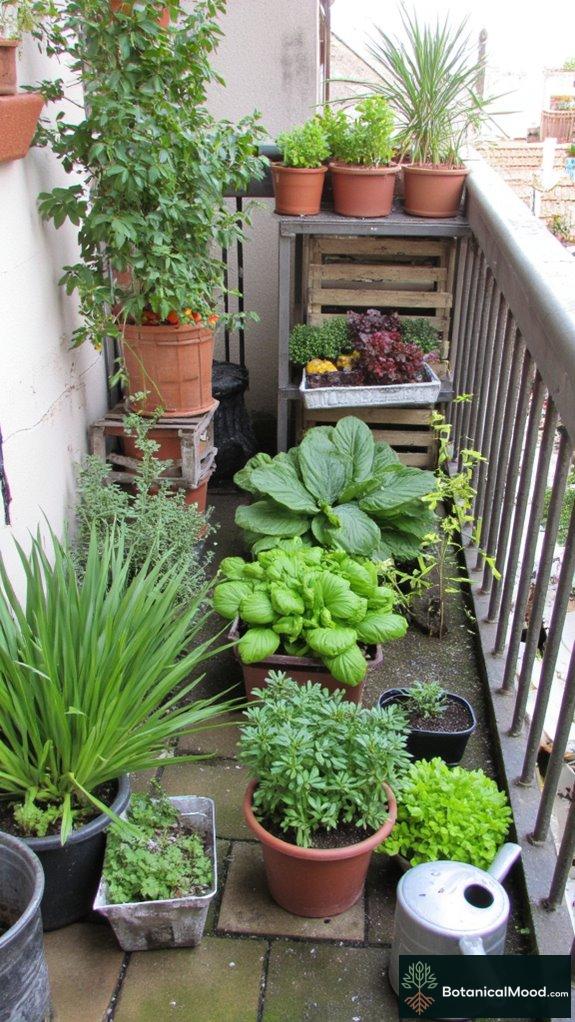
After a season of vertical herb walls, I often recommend compact container vegetable gardens as the next step for balcony growers who want more yield without sacrificing design cohesion. Utilizing creative growing arrangements can maximize limited space while enhancing the visual appeal of your garden. I’ll show you how to pick containers, substrates, and cultivars so your tiny outdoor room reads as a planted tableau and a productive kitchen patch. Incorporating urban soil alternatives can improve drainage and ensure your plants thrive in limited space.
Hanging Planter Galleries
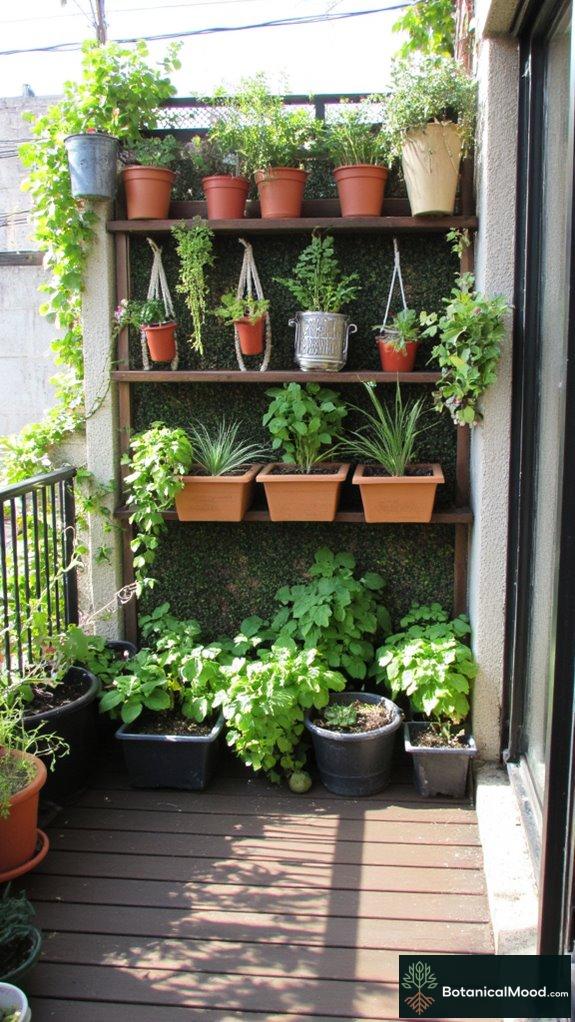
Although a vertical wall and a row of window boxes can define a balcony’s edge, I find that a carefully composed hanging planter gallery transforms that same space into a layered, kinetic tableau that reads as both sculpture and kitchen patch. Incorporating indoor living walls can further enhance the visual appeal and plant diversity within compact urban spaces.
I’ll show you how to balance aesthetics, load, and plant performance. Favor hanging botanical art, vertical space utilization, plant-care innovations. Additionally, incorporating small space design allows for unique arrangements that maximize both beauty and functionality in urban settings.
Miniature Raised Bed Solutions

Because space is scarce on many terraces and courtyards, I favor miniature raised beds—compact, elevated planters typically 60–120 cm long, 30–45 cm wide and 30–45 cm tall—that let you layer soil profiles, control drainage, and grow productive edibles or ornamental mixes even on a 2 m² balcony.
I’ll show you practical options that balance materials, load limits, and plant performance. Moreover, integrating vertical gardens into your design can transform even the smallest spaces into lush escapes.
I use compact growing systems and urban soil solutions, selecting lightweight cedar, coconut coir mixes and root barriers, showcased on Botanical Mood. Additionally, incorporating eco-friendly design strategies can enhance biodiversity in your small space.
Multi-Tiered Window Boxes
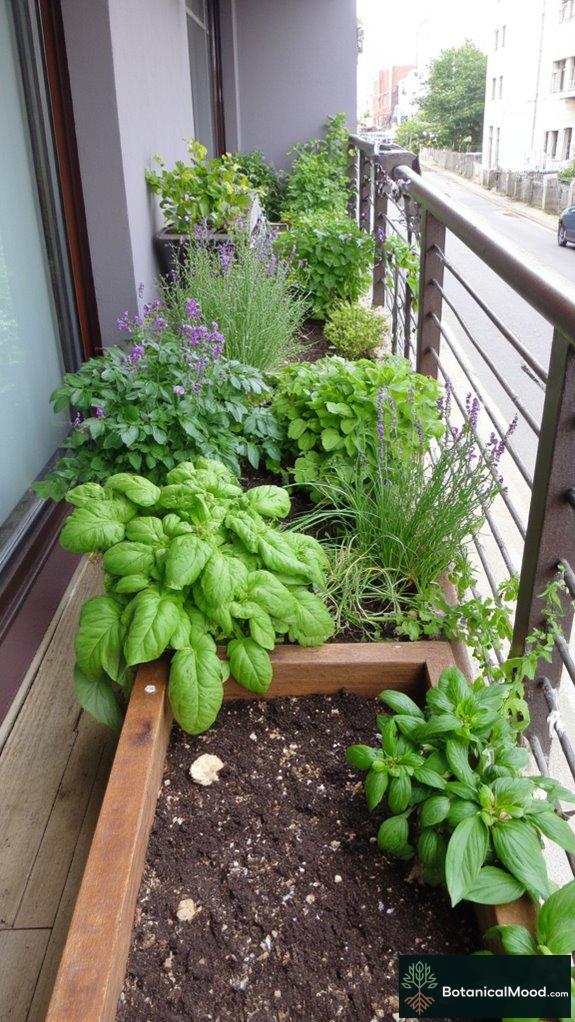
When I design multi-tiered window boxes I aim to stack function and beauty in tight elevation, so I often specify two- to four-tier systems that fit 60–180 cm window widths, with individual trough depths from 12 to 25 cm and planter lengths of 40–120 cm, giving you zones for shallow herbs like basil (Ocimum basilicum) and chives (Allium schooprasum), trailing succulents such as Senecio rowleyanus, and deeper-rooted ornamentals or salad greens; incorporating a DIY indoor herb garden wall can further enhance your vertical gardening efforts.
I favor lightweight materials—clear-coated cedar, powder-coated aluminium or UV-stable recycled PVC—paired with a coconut-coir/pumice mix and a root barrier to keep soil weight to roughly 12–18 kg per linear metre so typical balcony anchors and brackets handle the load without retrofit.
Additionally, incorporating vertical garden concepts not only enhances aesthetics but also maximizes the growing area in limited spaces.
- aesthetic arrangements, color coordination, seasonal plants
- space optimization, lightweight materials, DIY crafting
- drip irrigation installation, sustainability practices, natural pest control
- attractors for urban wildlife, pollinator-friendly species (Salvia, Nepeta)
- modular brackets, root barriers, maintenance schedules and plant spacing
Foldaway Balcony Garden Stations

I design foldaway balcony garden stations to give you full planting function in limited space, using hinged platforms 30–60 cm deep that fold flat to 8–12 cm, powder‑coated aluminium arms, stainless‑steel hinges or gas struts, 15–30 kg capacity per shelf, marine‑grade decking, coconut coir/perlite substrate, integrated driplines, lockable brackets, modular foldaway garden tools for balcony space optimization, slate botanical green palettes schemes. Additionally, these designs encourage maximizing urban garden space by providing tailored solutions that enhance both aesthetics and functionality. These stations can also support small city patio gardens by making it easier to grow a variety of plants in compact areas.
Modular Stackable Planters

Three-tier modular stackable planters give you vertical gardening power in tight urban settings, offering configurable depths, drainage, and irrigation options that make intensive planting both beautiful and practical.
- stackable designs, modular kits
- vertical options, customizable heights
- eco-friendly materials, lightweight structures
- interchangeable sections, easy assembly
- urban modularity, space utilization
Incorporating modular raised garden beds can further enhance the functionality and aesthetics of your urban garden. Furthermore, these systems can be designed to incorporate rainwater harvesting techniques, maximizing sustainability in your planting approach.
I developed Botanical Mood to showcase elegant, efficient urban planting solutions daily.
Creative Trellis Curtains

Building on the compact logic of modular stackable planters, I often recommend creative trellis curtains as a way to add living privacy, seasonal color and vertical biomass to balcony and courtyard gardens, using materials and attachments that suit scale and exposure. Trellis designs can be fabricated from recycled materials, emphasizing sustainability while providing structural support for climbing plants. Sensory gardens, which often feature textured leaves and fragrant blossoms, can enhance the experience of a trellis curtain setup. Highlight trellis designs, curtain materials, privacy enhancements, decorative elements, plant selections, versatile usage, artistic displays, seasonal variations, color schemes, maintenance tips.
Pocket Planter Living Walls

How does a pocket planter living wall turn a blank façade or narrow balcony into a layered, low-footprint ecosystem that yields color, fragrance and habitat while respecting weight limits and exposure? I choose modular pocket planters for resilient, elegant upright ecosystems, as on Botanical Mood. These living walls can feature minimalist vertical gardens, which maximize plant variety while conserving space.
- substrate depth shallow roots
- drip irrigation reservoirs
- east-west exposure zoning
- mixed textures trailing
- vertical gardening, pollinator habitat
Incorporating modern landscape lighting techniques can enhance the visual appeal of these living walls during the evening, creating a magical ambiance in your urban space.
Rooftop Micro-Orchards
If you loved the layered economy of pocket-planter living walls, you’ll find rooftop micro-orchards extend that vertical logic into productive canopy, where dwarf fruit trees, espaliered standards and large containers create a compact, productive garden above the cityscape.
I favor espaliered Malus domestica.
Explain urban orchard benefits and rooftop gardening techniques, palette, wind screening, load limits, and why I founded Botanical Mood.
Slimline Succulent Displays

Tray- and trough-based arrangements let me create narrow, sculptural bands of succulents that fit a balcony rail, windowsill, or rooftop parapet without crowding circulation, and I’ll show you the practical particulars that make them thrive. I favour succulent stacking and minimalist designs, choosing echeveria (Echeveria spp.), sedum, haworthia for texture; Botanical Mood. By incorporating compact herb and vegetable planter styling, these displays can also support a variety of culinary plants that flourish in small spaces. Using sleek minimalist concrete planters enhances the aesthetic while providing proper drainage and stability for plant roots.
- shallow trays
- gritty mix
- staggered heights
- drip emitters
- successional planting
Space-Saving Edible Terraces
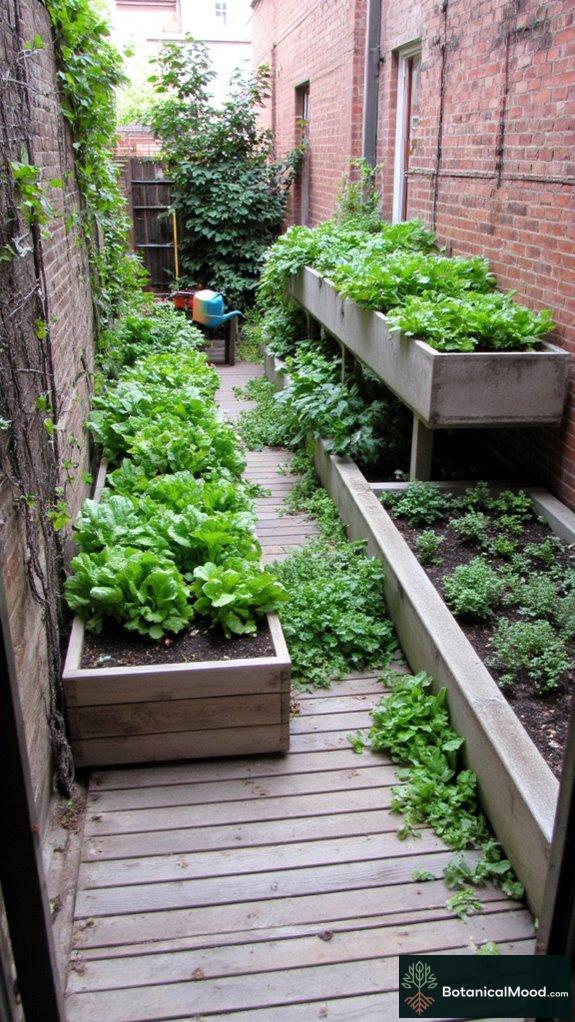
Because urban plots demand efficiency and beauty, I design space-saving edible terraces that stack productive layers of vegetables and herbs into narrow footprints, using tiered planters, stepped troughs, or modular shelving to fit balconies, patios, and rooftop parapets without sacrificing circulation. Incorporating regenerative garden principles allows these designs to flourish sustainably while maximizing yields. Utilizing edible landscaping techniques enhances aesthetic appeal and allows for a harmonious blend of beauty and functionality in urban spaces. Using space-efficient designs, vertical-gardening techniques, urban-rooftop utilization, modular-planting systems, edible-gardening options, sustainable-garden features, multi-level planting solutions, diverse-crop decorative-terracotta planters, versatile-planting arrangements.
Reclaimed Wood Pallet Gardens
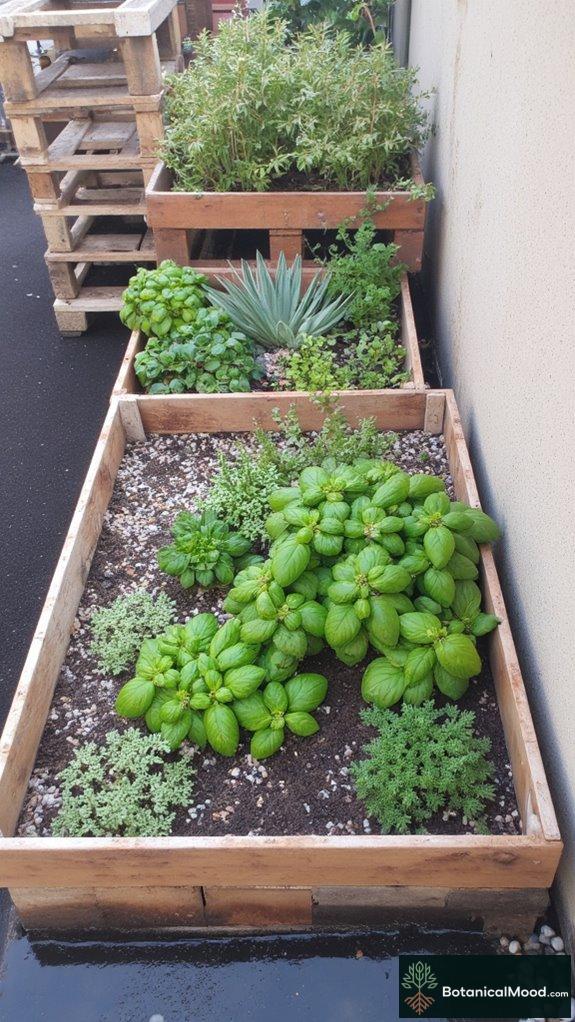
When I repurpose a reclaimed wood pallet into a garden, I start by evaluating species, condition, and safety—cedar or redwood slats resist rot, whereas old pine or pressure-treated boards can leach chemicals and should be avoided or sealed. Using reclaimed wood not only adds character but also promotes sustainable practices by reducing waste and reusing materials.
Then I disassemble or modify the pallet to create planting beds, stacked troughs, or a wall-mounted frame that maximizes a small balcony or rooftop parapet.
- drainage
- herbs
- succulents
- fasteners
- sealant
I explore pallet upcycling techniques and rustic aesthetics on Botanical Mood, recommending oregano (Origanum vulgare), sedum (Sedum spp.), compact basil, and clear finishes for durability and design. Integrating sustainable water features can also enhance the overall beauty and functionality of your pallet garden.
Slim Rail-Mounted Planters
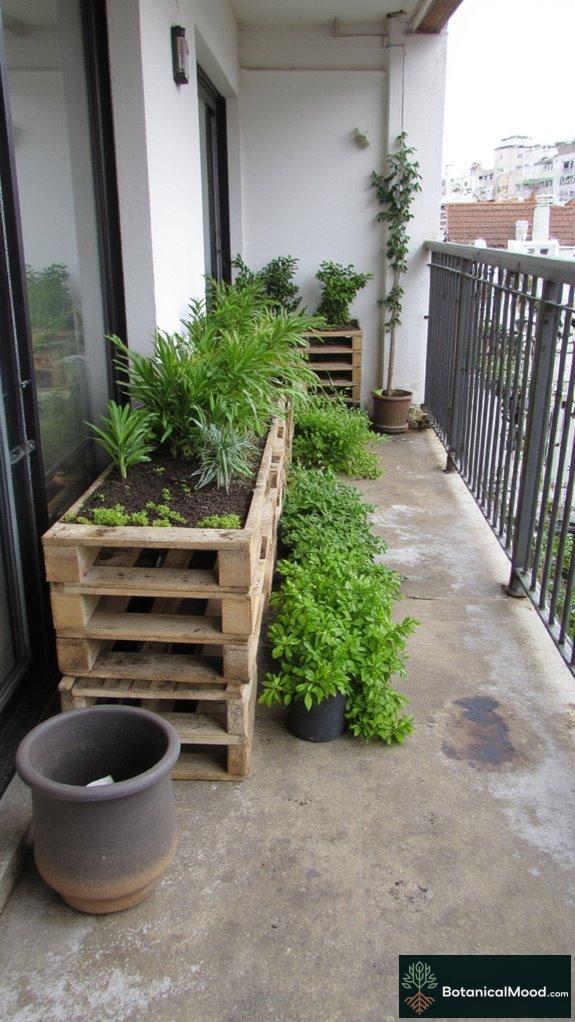
After working with reclaimed pallets I often turn my attention to rail-mounted planters as a space-saving alternative that suits narrow balconies and rooftop parapets. I’ll show you how a slim, thoughtfully specified trough can deliver both form and function. I favor sleek design, urban aesthetics, innovative materials, planter versatility, urban gardening, maximizing space, sustainable solutions, DIY-options, eco-friendly designs, sedum (Sedum spp.). These rail-mounted planters not only enhance the visual appeal of small spaces but also allow for modular expansion options that can transform an ordinary area into a lush urban oasis. By incorporating modern lighting techniques, you can create striking shadows and highlights that further elevate the ambiance of your garden space.
Convertible Bench Planter Hybrids

I like to think of convertible bench-planter hybrids as compact, multi-functional installations that turn a simple seat into an active planting bed. I’ll show you how choices in materials, proportions, and planting palettes make them equally suitable for narrow terraces, rooftop lounges, and community courtyard edges. These innovations can significantly enhance urban balcony garden design by incorporating greenery even in the smallest of spaces. Additionally, these designs can promote biodiversity in urban ecosystems by attracting beneficial pollinators and other wildlife.
- modular
- cedar
- drainage
- Lavandula angustifolia
- seating
I design transformable outdoor furniture for multifunctional green spaces.
Mirror-Backed Plant Corners

A mirror-backed plant corner amplifies light, depth, and foliage rhythm in tight outdoor rooms, and I’ll show you how careful choices in mirror type, framing materials, and plant palette make these installations both durable and beautiful on terraces, balconies, and sheltered rooftops. Incorporating creative pergola decorations can further enhance the overall aesthetic and functionality of these spaces.
I specify acrylic, powder-coated frames, planters, pairing Philodendron (Philodendron hederaceum) for reflective plant displays. Creative Concepts for Vertical Garden Photo Arrangements are essential to visualize the final outcome and inspire unique designs.
Botanical Mood guides dynamic lighting effects.
Green Staircase Makeovers

Stepping from mirror-backed plant corners into green staircase makeovers, I find the same principles of light amplification, reflective rhythm, and plant scale guiding how vertical circulation can be softened and enlivened. The integration of topographical garden forms can elevate the aesthetics and functionality of these urban spaces, much like the careful arrangement of rocks and gravel in Japanese Zen gardens that creates a harmonious balance.
I’ll show you practical options for materials, plant palettes, and irrigation that suit terraces, townhouse stoops, and rooftop approaches; think modular planter risers and powder-coated steel troughs mounted to risers or railings, EPDM-lined timber planters inset into terrazzo or concrete treads, integrated dripline with pressure-compensating emitters for even moisture, and low-voltage (12V) LED step lighting to protect foliage at night.
- Material choices: powder-coated steel, EPDM, teak, terrazzo accents.
- Plant palettes: Sedum (Sedum spp.), Carex (Carex spp.), ferns for shade.
- Irrigation: drip with pressure-compensating emitters, smart controllers.
- Lighting: 12V LED step washes to enhance green staircase aesthetics.
- Benefits: improved urban greenery benefits, microclimate cooling, biophilic appeal.
Compact Citrus Tree Containers
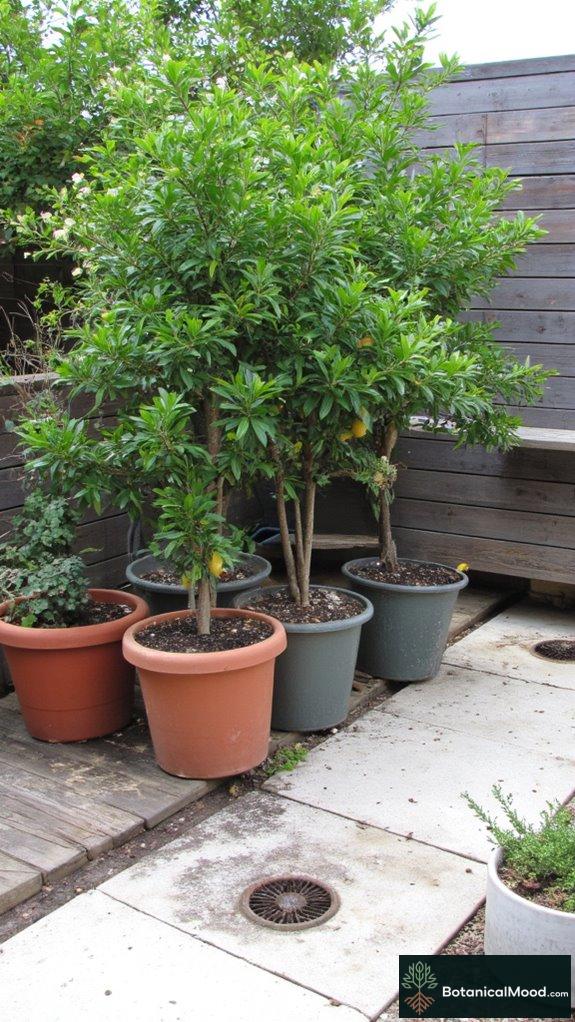
Container citrus brings concentrated fragrance, glossy evergreen foliage, and year-round ornamental fruiting to balconies, terraces, and compact courtyards.
When you choose the right combination of cultivar, container, substrate, and management you can reliably grow Meyer lemon (Citrus × meyeri), calamondin (Citrus × microcarpa) or dwarf bearss/persian-type limes (Citrus × latifolia) in pots measuring roughly 15–25 gallons (60–95 L) with interior root depths of 45–60 cm to allow seasonal root expansion without excessive weight for rooftop decks.
I select citrus varieties, pair decorative pots with precise soil selection, manage sunlight needs and watering routines, monitor pest management, choose fertilizer options and organic practices, plan indoor placement and winter care. Additionally, incorporating sustainable gardening practices not only enhances the health of your citrus plants but also contributes to environmental stewardship.
I drew inspiration from Botanical Mood when shaping these compact, innovative container designs.
Mobile Cart Kitchen Gardens

Having coaxed Meyer lemon (Citrus × meyeri) and calamondin (Citrus × microcarpa) to perform beautifully in limited footprints, I’ve found mobile cart kitchen gardens bring ornamental and productive qualities to tiny urban niches. These designs embrace the simplicity of minimalist gardens, allowing for a clean aesthetic that harmonizes with any urban setting.
I’ll show you practical builds—cedar or powder‑coated steel, 30 cm trays, heavy casters, internal drip lines, plus mobile garden tools and urban gardening kits, compact, mobile, elegant options. These gardens not only maximize space efficiently but also embody the principles of modern minimalist garden aesthetics, ensuring beauty is integrated with functionality.
Suspended Glass Terrariums

When you want to introduce a pocket of living atmosphere into a narrow stairwell, balcony overhang, or sunlit kitchen corner, suspended glass terrariums offer an elegant, space‑efficient solution that I often specify for urban projects because they marry form and microclimate so effectively;
I favor handblown or borosilicate globes and geometric pendants in diameters from about 10–30 cm, hung on brass or black powder‑coated fittings with stainless steel cable and rated ceiling anchors (6–12 kg working load) to guarantee safety and longevity.
I recommend plants like Fittonia (Fittonia albivenis), small ferns (Asplenium), or Pilea (Pilea peperomioides) to enhance suspended plant aesthetics, while pragmatic glass terrarium maintenance—ventilation, precise watering, occasional cleaning—keeps microclimates balanced, a principle I refined when creating Botanical Mood.
Urban Pollinator Patch Designs
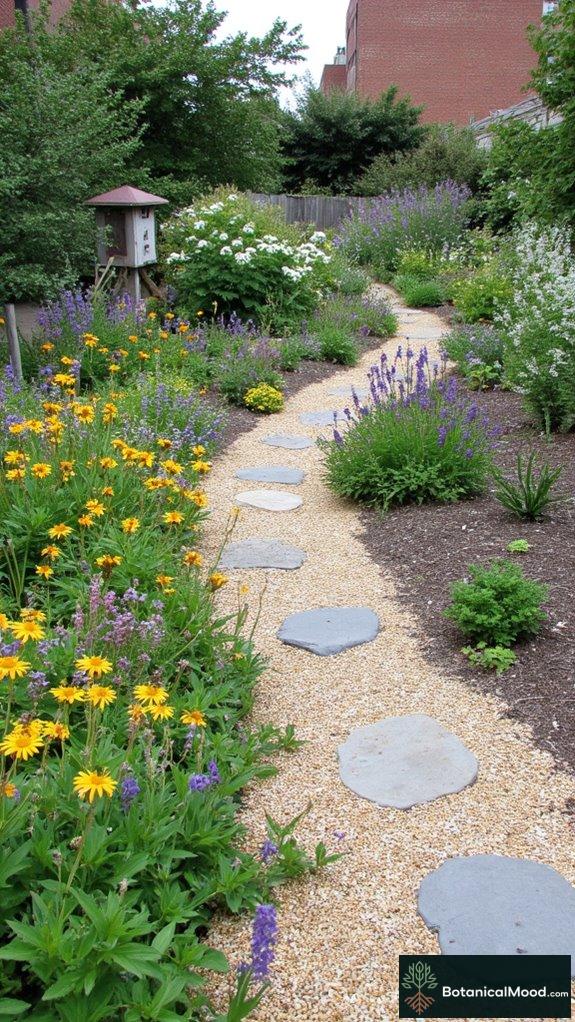
Because urban sites need concentrated floral resources, I design pollinator patches as compact, high‑value assemblages. I specify native wildflowers, flowering shrubs, insect hotels, modular containers, and pollinator pathways to support bee friendly gardens, butterfly habitats, urban beekeeping, sustainable landscaping, and garden diversity. Incorporating diverse native wildflower species can significantly enhance the attractiveness of urban gardens for essential pollinators. Furthermore, creating these habitats not only benefits local pollinator populations but also encourages community engagement with nature.
- pollinator plants mix
- native wildflowers palette
- insect hotels shelters
- Lechuza modular planters
- pollinator pathways and garden diversity
Join Botanical Mood
Balcony Privacy Screens With Plants

On narrow city balconies I often recommend living screens that marry form and function, so you get vertical privacy while preserving pollinator resources and a sense of enclosure. By selecting sustainable plant species, you not only enhance the aesthetic appeal but also contribute to a more environmentally-friendly urban ecosystem. I’ll show how species selection, container depth, structure type and planting density work together to create layered screening that’s both beautiful and practical. Additionally, considering companion planting strategies can enhance biodiversity and support the health of your privacy plants while maximizing space in your urban garden.
Mini Water Features for Small Yards
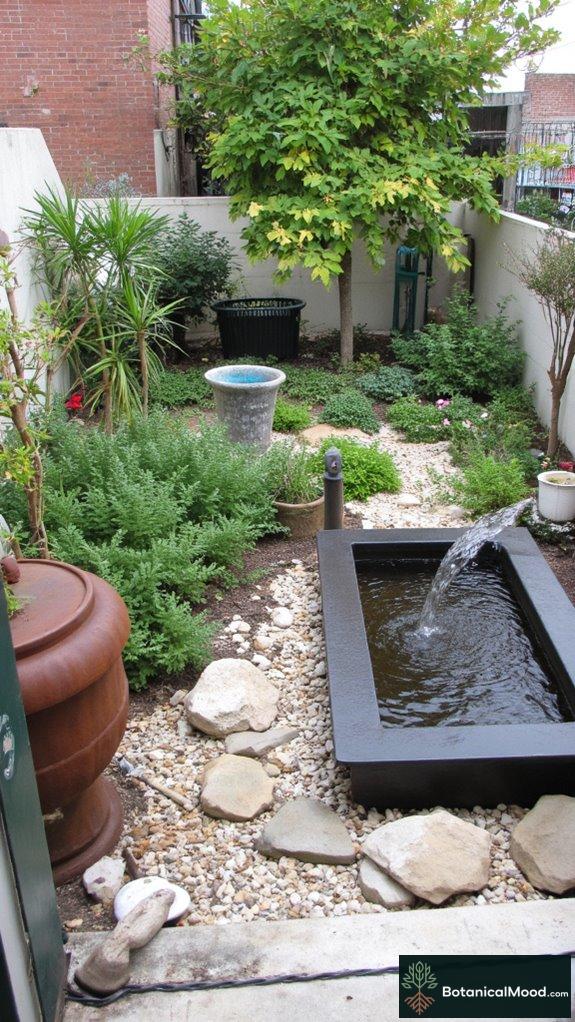
If you’re considering a water feature for a compact yard, I recommend thinking regarding scale, sound, and maintenance from the outset, because a well-proportioned element—whether a 60 cm tall corten-steel urn, a glazed ceramic bowl from brands like Campania or Bosmere, or a small container pond inset at 40–50 cm depth—can read as a room-defining focal point without overwhelming sightlines or floor space. Additionally, choosing the right backyard fountains can enhance the tranquility and aesthetic appeal of your urban garden design. Incorporating industrial water features not only elevates the design but also creates a unique interplay between light and sound, enriching the overall experience of your space.
Layered Planter Boxes for Depth

A handful of staggered planter boxes placed at varying heights will instantly add spatial depth to a narrow patio or courtyard. I often recommend combining cedar or galvanised-steel vessels, Lechuza self-watering inserts, and a few terracotta or glazed pieces from makers like Elho to create a layered composition that reads as a living stairway rather than a single flat bed. Incorporating a variety of layered textures not only enhances the aesthetic but also supports different plant species’ needs for sunlight and moisture. Utilizing decorative wooden planter boxes can further enhance the visual appeal of your urban garden.
Slim Vertical Fruit Towers
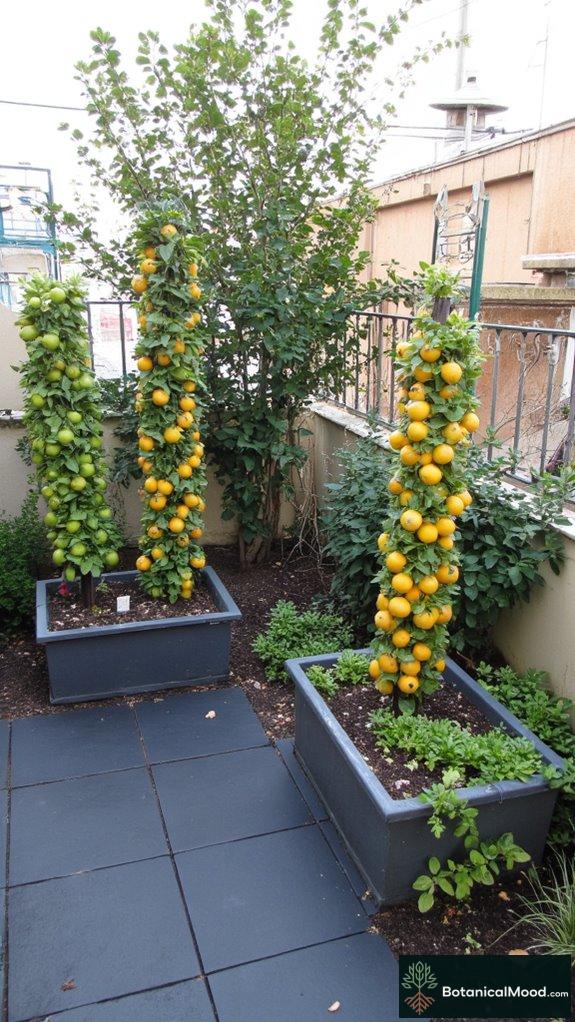
Slim vertical fruit towers transform tight patios and balconies into productive, sculptural orchards. I often recommend them when space is limited because they stack productive planting pockets vertically, saving square footage while keeping maintenance ergonomic for pruning and harvest. These towers can also enhance soil management strategies, ensuring that your plants receive the nutrients they need for optimal growth. Incorporating ornamental plants alongside fruit-bearing varieties can create a visually appealing garden that is both functional and beautiful.
- fruit-tower-benefits, urban-gardening-techniques
- vertical-growing-tips, sustainable-design-practices
- space-optimization-ideas, aesthetic-garden-solutions
- soil-management-strategies, plant-variety-selection
- irrigation-systems-efficiency, seasonal-fruit-planting
I curate examples, color palettes, and pragmatic methods on Botanical Mood daily.
Corner-Filling Triangular Planters
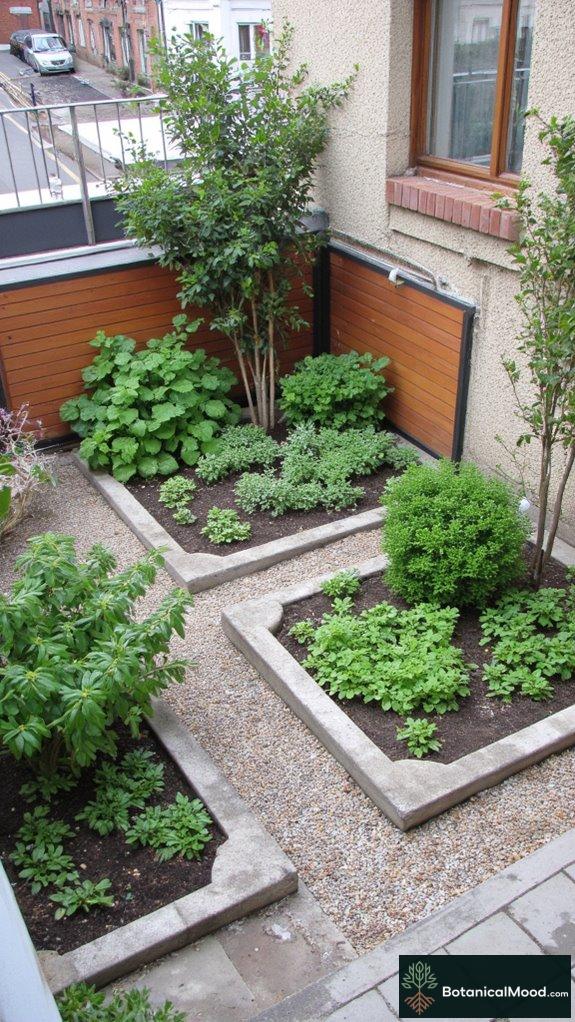
The corner of a balcony or courtyard can become a sculptural, productive nook when I fit a triangular planter—whether equilateral for symmetry or a right-angled wedge to follow building lines—that maximizes otherwise wasted floor area while keeping planting, pruning, and harvest within arm’s reach. I balance triangular planter aesthetics, efficient corner gardening using Ocimum basilicum (basil) and Sedum spp., showing Botanical Mood. Incorporating low maintenance pathways in the garden design further enhances the overall minimalist aesthetic while reducing upkeep. Utilizing geometric landscape structures in triangular borders can not only promote sustainable gardening but also enhance the visual appeal of urban spaces.
Ledge Gardens for Fire Escapes

When I design ledge gardens for fire escapes, I treat the narrow steel platforms as vertical-thoughtful environments, choosing shallow galvanized troughs and lightweight fiberglass window boxes rated for low-profile urban use. I size containers to keep wet weight under about 20–25 lb (9–11 kg) per linear foot so the load stays within typical residential limits and doesn’t interfere with municipal egress requirements. Incorporating integrated water features can enhance both aesthetics and biodiversity in these compact spaces, creating habitats that mimic the biodiversity found in a tropical forest canopy.
Low-Maintenance Native Plant Pockets
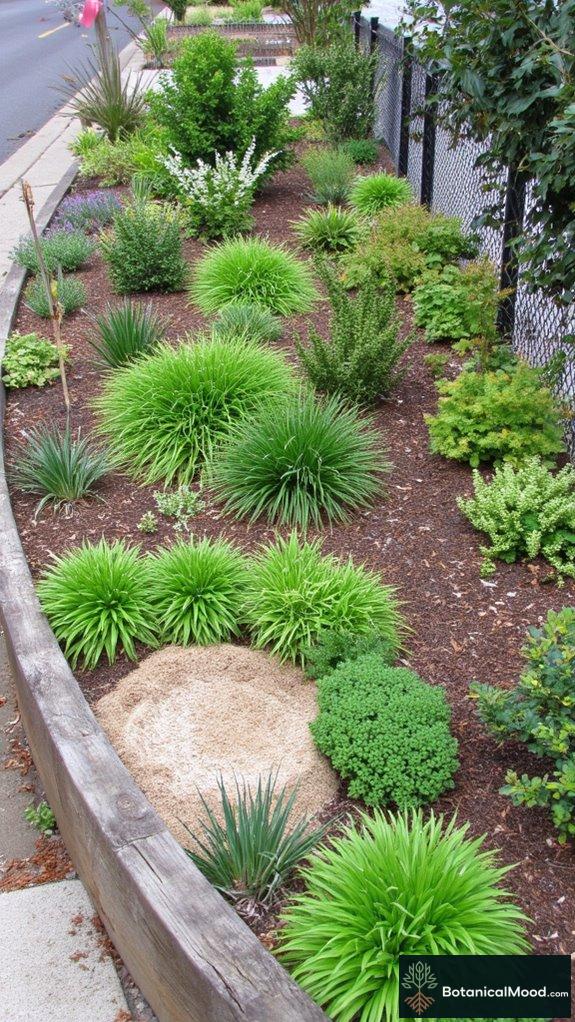
Because I prefer designs that work quietly with local ecosystems, I plan low‑maintenance native plant pockets around sun, soil, and wind, using coir‑based mixes, eco friendly fertilizers and composting techniques to boost soil health improvement, creating pollinator friendly plants, seasonal native blooms and aromatic native herbs for wildlife supporting habitats, rain garden integration, shade tolerant varieties, drought resistant designs and self-sustaining ecosystems. Incorporating bee-friendly plants can significantly enhance the garden’s ability to attract and support important pollinators.
Bicycle Basket Plant Displays

Although compact in scale, bicycle basket plant displays can transform a city commute or balcony vignette into a moving tableau of color and texture.
I’ll show you how to balance aesthetics with practical constraints like weight, drainage, and sun exposure.
- Sedums
- Secure mounts, lightweight durable
- Self-watering liners
- Mix trailing, upright foliage (Pelargonium)
- Emphasize bicycle planter aesthetics, vintage bike displays, Botanical Mood
Narrow Alleyway Green Corridors

If you step into a narrow alleyway and look up, you can immediately sense how a deliberate green corridor transforms compressed urban light and airflow into a sculpted, living room—so I plan plant palettes and hardscape details to suit the unique microclimate of each passage, measuring reflected light in lux, noting prevailing breezes, and choosing species and systems that thrive in 50–500 lx shade gradients.
I design alleyway greenery and vertical routes to boost urban biodiversity, hidden gardens, green infrastructure, pedestrian friendly spaces, sustainable design and city aesthetics, inviting community involvement with narrow pathways, Latin species like Ficus microcarpa (Ficus) and Hedera helix (Hedera), and I mention Botanical Mood as inspiration.
Biophilic Entryway Makeovers

When I approach an entryway I think regarding sensory thresholds—light, scent, texture—and design a biophilic sequence that eases the shift from street to shelter, balancing practical metrics like 200–800 lx measured at eye height with softer experiential elements such as fragrant foliage, tactile materials, and layered sound from water features;
I select compact structural specimens like Fatsia japonica (Fatsia) and Buxus sempervirens (Buxus) for low-maintenance framework, pair them with seasonal accents—Dianthus barbatus (Dianthus) for spring color and Heuchera spp. (Heuchera) for year-round leaf contrast—and specify permeable paving, warm-toned terrazzo or honed bluestone for approach surfaces to reduce glare and channel rainwater to bioretention planting pockets.
- Integrate biophilic design principles with layered planting.
- Choose sustainable materials like permeable pavers, terrazzo, bluestone.
- Prioritize 200–800 lx illumination, tactile finishes, acoustic masking.
- Use compact taxa (Fatsia, Buxus, Heuchera, Dianthus) for structure.
- Direct runoff to planted bioretention pockets, enhancing soil biology.
DIY Hanging Bottle Herb Racks

I often carry the same sensory logic from entryway schemes into small-scale, functional installations.
For a practical, sculptural herb rack, I design with light, scent and tactility in mind and prioritize materials and proportions that suit a balcony, kitchen alcove or sun-facing wall.
DIY hanging bottle herb racks use upcycled bottles to enable vertical gardening, plant organization and urban sustainability herb preservation.
Compact Shade Garden Ideas

Although north-facing balconies and shaded courtyards limit direct sun, I design compact shade gardens to maximize texture, layered foliage, and cool color palettes so you can enjoy lush, living compositions in tight urban spaces.
- shade loving plants, good soil drainage
- seasonal blooms, unique foliage (Hosta spp.)
- companion planting, native species
- plant height variation, ground cover options
- color combinations, wildlife attraction; Botanical Mood
Painted Container Focal Points

Because painted containers can transform a modest balcony or courtyard into a deliberate focal point, I outline practical paint choices, container materials, and planting strategies that help you achieve lasting visual impact and horticultural success, whether you’re working with terracotta, galvanized steel, fibreglass, or reclaimed wooden tubs.
I use paints, pair Lavandula (Lavandula angustifolia), creating colorful container designs and artistic planter placements.
Indoor-Outdoor Transition Gardens
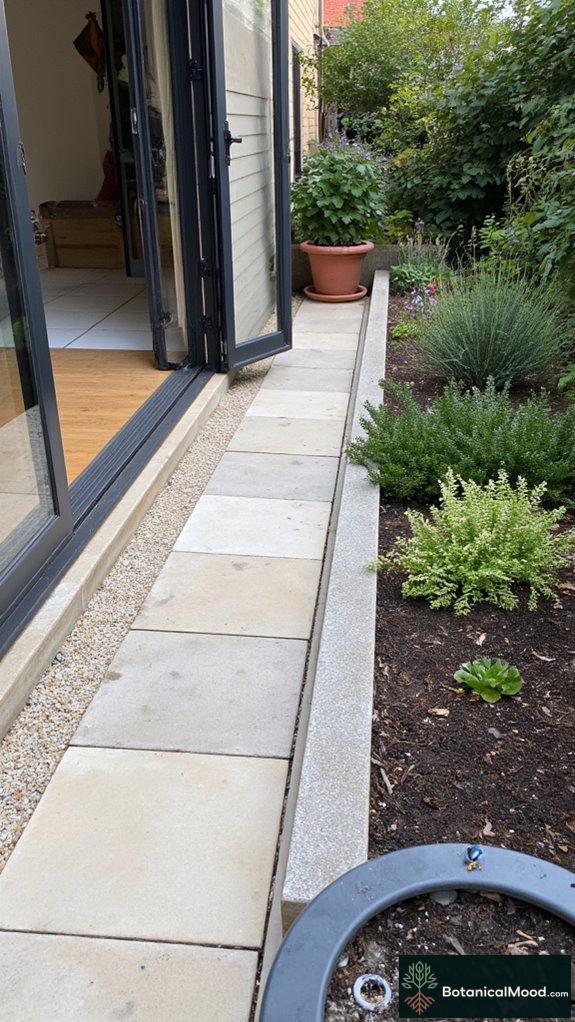
Seamless thresholds, from sliding glass doors and bifold systems like LaCantina to recessed deck-to-floor changes, become the defining lines where an indoor palette and outdoor planting scheme converse.
Getting those details right—floor levels, weatherstrips, thermal breaks, and a well-drained paving substrate—ensures the garden reads as an extension of the interior rather than a separate room.
- I
- indoor plant
- seasonal
- sensory
- wildlife
Compact Zen Garden Concepts
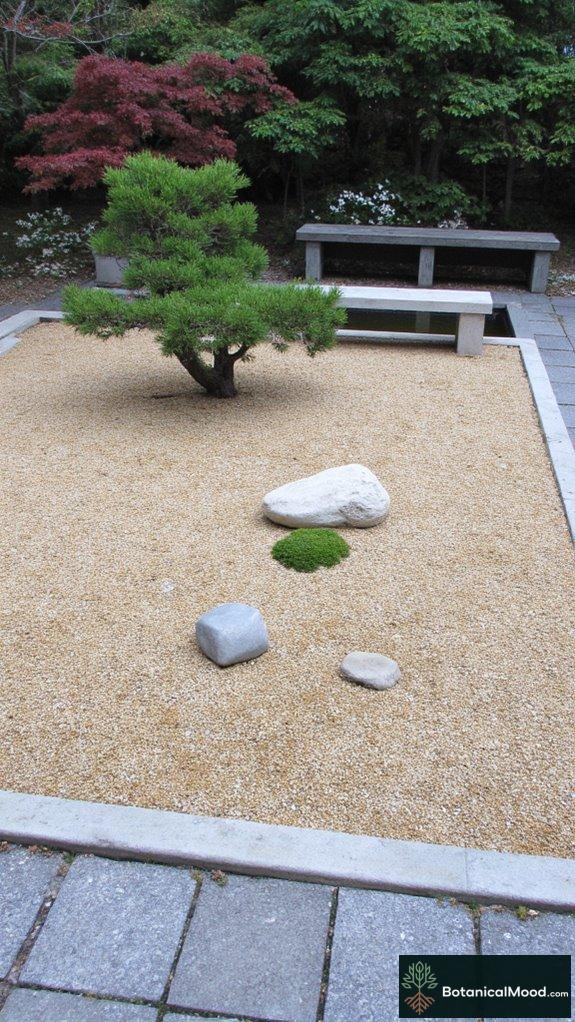
When I design a compact Zen garden for an urban courtyard, I focus on scale, rhythm and restraint so a 3 x 4 metre space can feel expansive, calm and intentionally composed. I use fine-grain gravel or crushed granite for raked surfaces, larger accent stones placed with the ishi-no-ma principle, and low plantings such as moss (Bryophyta), dwarf Japanese maple (Acer palmatum ‘Koto’ or ‘Shaina’) and cloud-pruned nandina (Nandina domestica) to keep sightlines low and maintenance predictable.
I explore zen rock arrangements, minimalist water features, muted palettes, textured pavers, subtle lighting, and compact seating. I mention Botanical Mood as a reference for materials and contemporary construction details.
Urban Balcony Orchard Vignettes

I often configure urban balcony orchard vignettes as compact, layered compositions that bring productive planting into tight city footprints, arranging columnar apples (Malus domestica ‘Northpole’), espaliered pears (Pyrus communis on M9), dwarf peaches (Prunus persica on Gisela 5) and container citrus (Citrus × sinensis or C. limon) so they read like a small, cultivated room rather than a cluttered collection of pots.
I pay careful attention to aspect, load-bearing limits, wind exposure and microclimates created by adjacent facades.
- Light optimization, southern aspect, 6–8 hours
- Soil mixes, 50% loam, 30% compost, 20% perlite
- Modular containers, lightweight resin, steel frames
- Pollination strategies, bees, hand-pollination windows
- Aesthetic palette, citrus greens, blush peaches, autumn red
I highlight balcony fruit and urban orchard strategies, a focus I developed while creating Botanical Mood.
Compact Hydroponic Window Farms
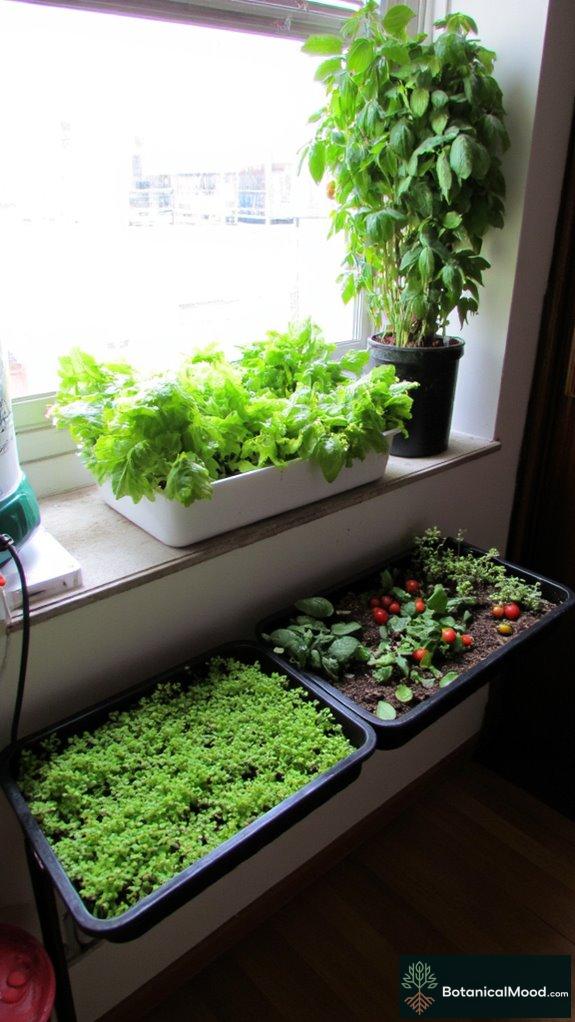
Window-facing hydroponic racks bring a surprising intensity of productivity to small apartments, and I’ll walk you through how compact systems—such as AeroGarden-style countertop units, ZipGrow towers, or shallow NFT trays—can be configured to fit narrow sills while delivering reliable yields of lettuce (Lactuca sativa), basil (Ocimum basilicum), cherry tomato (Solanum lycopersicum var. cerasiforme) and microgreens, all within the 30–60 cm depth common to urban windows.
Small-Space Year-Round Grow Setups

Although compact footprints demand careful trade-offs, you can build a year‑round grow system in a 60 × 60 × 140 cm tent or on a three‑tier shelving unit that delivers predictable yields, controlled microclimates, and a pleasing aesthetic that fits an apartment, balcony alcove, or kitchen corner.
- I test systems
- hydroponic balcony systems
- indoor grow lights
- microclimate automation standards
- Botanical Mood blog
Layered Color-Blocking Plant Arrangements
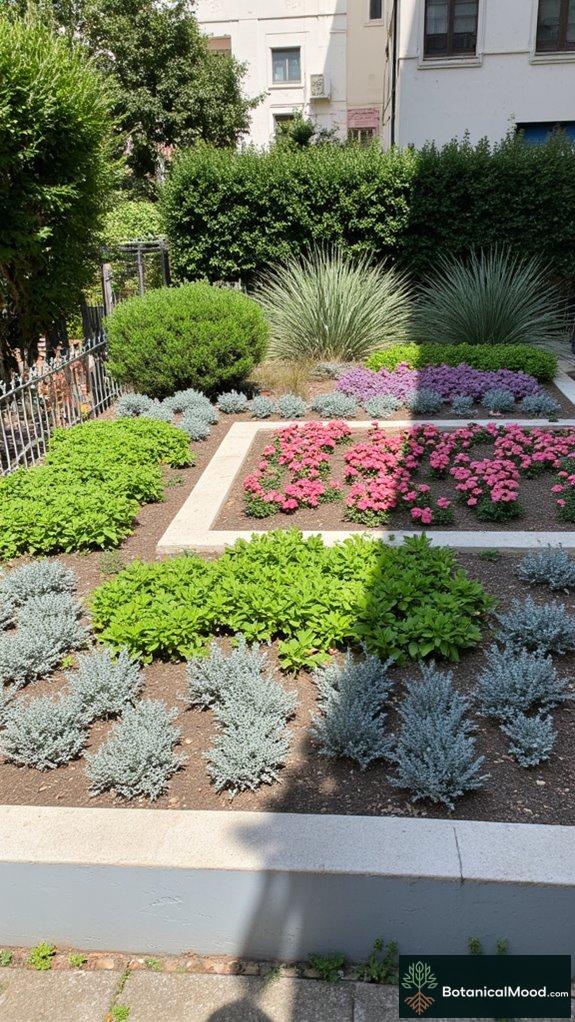
When I plan a layered color-blocking scheme, I set up three clear horizontal bands—foreground, midground, and backdrop—so each layer contributes distinct hue fields, textures, and bloom timings that read at a glance from a balcony, courtyard, or compact patio.
Botanical Mood applies color theory, plant harmony, seasonal palettes, texture contrasts, bold-accents, monochromatic schemes, contrasting hues defining focal points, visual layers, artistic arrangements.
Rustic Urban Raised Planter Boxes
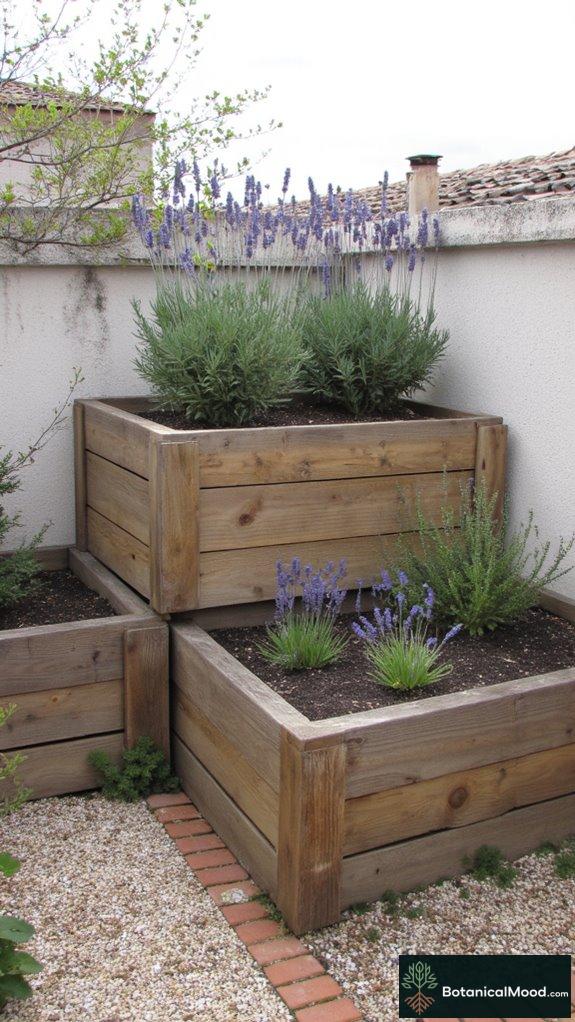
Three stacked cedar boxes, each 30–40 cm deep, anchored on a compact rooftop or courtyard, make an elegant, rustic urban raised planter system I can install quickly.
They give me the structural framework to layer soil, drainage, and plant selections so each tier reads clearly from a balcony.
- rustic-aesthetics, cedar, Lavandula
- raised-construction, planter-durability, modular
- natural-materials, eco-friendly-design
- outdoor-functionality, space-optimization, rooftop
- gardening-accessibility, Botanical
Slimline Composting Solutions

Keeping the cedar tiers thriving means dealing with kitchen and yard waste in a way that fits narrow urban footprints.
So I look to slimline composting systems designed for balconies and compact rooftops that give me high-efficiency decomposition without taking up the footprint of a bulky bin.
I mention Botanical Mood, using bamboo composters, compost tumbler systems, composting worms, odor free composting.
Balcony Lighting and Plant Pairings

If you orient lighting around both function and mood, you can pair fixtures and plants so a small balcony reads as an intentional room rather than a cluttered collection.
I’ll show you how to balance lumen output, color temperature and plant needs to achieve that effect.
I curate ideas, Botanical Mood.
- fairy lights
- solar options
- energy efficiency
- color schemes
- safety considerations
Microclimate Planting Strategies

Although small urban spaces often look uniform at first glance, I map microclimates—sun-exposed south walls that store heat and radiate it at night, north-facing alcoves that stay cool and damp, wind-swept roof terraces, and sheltered courtyard pockets—to decide which plants, soils and irrigation systems will thrive where.
microclimate-benefits, weather-sensitive-planting, temperature-regulation, humidity-control, windbreak-strategies, shade-cultivation, seasonal-adaptations, pest-management, soil-health, irrigation-techniques, diverse-planting, sun-exposure-analysis, companion-planting, urban-heat-islands, greenhouse-effects
Compact Edible Flower Designs
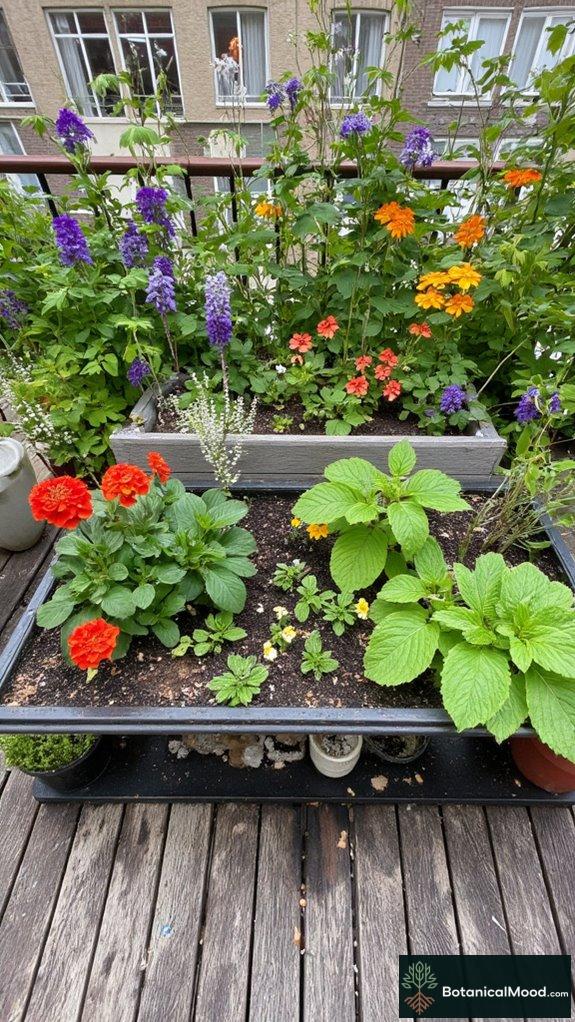
When I design compact edible-flower beds I start by choosing plants that marry intense color, culinary utility and small footprints, so that a single 45–60 cm (18–24 in) raised trough or a 30 cm (12 in) patio pot can yield successive harvests for salads, cocktails and garnishes; varieties like nasturtium (Tropaeolum majus), calendula (Calendula officinalis), borage (Borago officinalis), violas (Viola spp.), and compact chive blooms (Allium schoenoprasum ‘Forescate’) give bold, contrasting hues, spanflower textures, and predictable bloom windows.
While dwarf cultivars and designated “patio” selections reduce internode length and prevent overcrowding.
- edible flower varieties, flower planting tips
- culinary flower benefits, edible flower recipes
- flower pairing ideas, garden aesthetic appeal
- attracting pollinators, seasonal flower guides
- edible flower preservation, DIY flower arrangements
Space-Efficient Vine Training Systems

For compact spaces I favor vertical frameworks that squeeze maximum yield and visual impact into minimal square footage.
So I design systems—wire trellises, A-frame obelisks, espalier stakes, and modular living walls—that support species from Vitis vinifera grapevines to Passiflora edulis and companion cucurbits (Cucurbita pepo) while maintaining tidy canopy height and easy harvest access.
I’m using eco friendly materials, flexible planting grids.
Portable Pop-Up Garden Ideas

Having relied on vertical frameworks to push production skyward in tight footprints, I also design portable pop-up gardens that bring flexibility, seasonal variety, and instant curb appeal to balconies, rooftops, and temporary event spaces.
This approach combines modularity with sturdy details—fold-flat raised beds and A-frame planters built from powder-coated steel and marine-grade plywood, UV-stable fabric pots (SmartPot-style) and pliable polyethylene GrowBags, rolling planter carts with lockable castors, and clear polycarbonate pop-up greenhouses that collapse for storage.
- Portable planter designs: fold-flat, lightweight planter options for easy transport
- Mobile garden kits and Instant garden setups for events and patios
- Easy assembly gardens with lockable castors, Quick green installations for pop up floral displays
- Transportable vegetable patches and Compact herb carriers, Versatile garden bags
- Brands like Gardener’s Supply and modular systems inspired by Botanical Mood
Balcony Yoga Garden Layouts
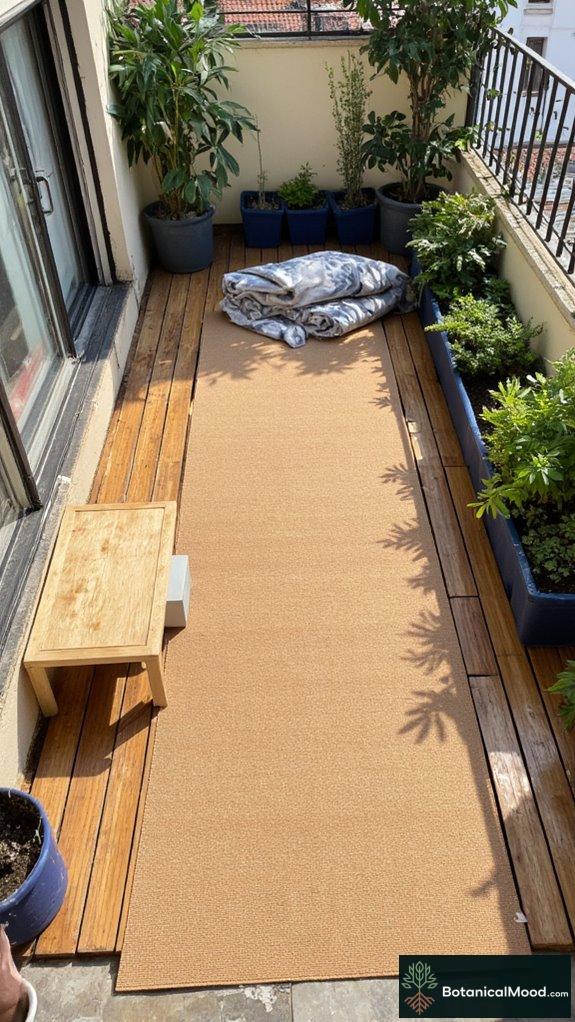
Although many balconies are compact, I design yoga garden layouts that prioritize a clear practice zone—typically 2.0 x 0.6 m to accommodate a standard 6 ft mat—while arranging surrounding elements to support balance, breath, and ease of movement;
I specify nonslip decking or interlocking bamboo slats (Phyllostachys spp.) over rooftop membrane, pair a cork or rubber yoga mat with a low-profile cedar bench for props and storage, and locate self-watering planters (Lechuza-style) and SmartPots at the periphery to keep the central floor unobstructed.
Mini Wildlife Habitat Corners

- plant species
- soil types
- pollinator plants
- eco friendly materials
- native species
Botanical Mood
Patterned Planter Arrangements for Visual Impact

How can patterned planter arrangements transform a patio into a mosaic, drawing the eye with rhythm, repetition, and contrast?
I guide you through colorful plant patterns and geometric planter designs, layered texture arrangements with (Lavandula angustifolia), rhythmic plant placements, bold pattern mixing, innovative planter shapes, contrasting color schemes, thematic arrangement ideas, seasonal pattern variations, and artistic arrangement concepts; I created Botanical Mood.
Vertical Pallet Garden Walls
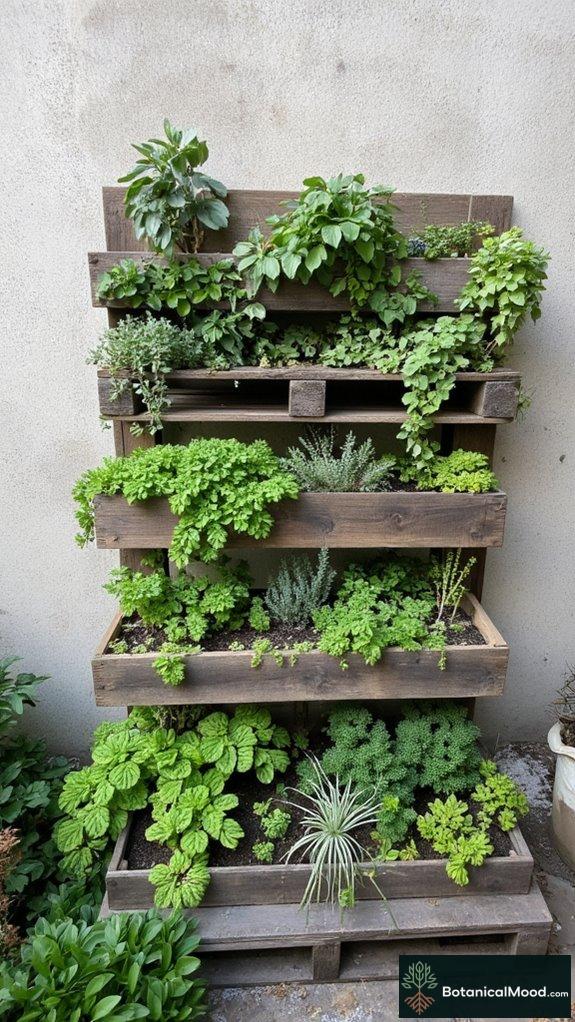
Vertical pallet garden walls represent an ingenious recycling strategy that transforms discarded wooden shipping pallets into stunning, space-efficient gardening canvases. These vertical gardens not only enhance the aesthetic appeal of your terrace but also contribute to vertical gardening techniques, which maximize the use of limited space in urban settings. Additionally, incorporating native plant species into these designs can promote local biodiversity and reduce maintenance needs.
Hanging Herb Basket Systems
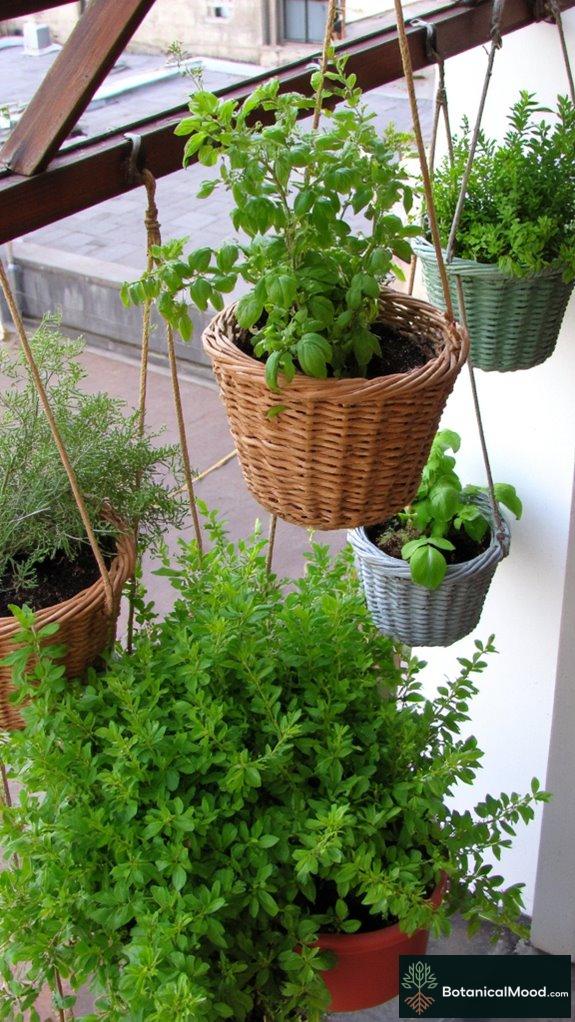
Building upon the innovative vertical gardening techniques explored with pallet walls, hanging herb basket systems offer another brilliant solution for maximizing garden space and culinary potential.
These versatile systems combine herb basket aesthetics with practical functionality, allowing gardeners to creatively arrange baskets using diverse materials like ceramic, woven rattan, and lightweight metal for ideal herb basket placement and maintenance. By embracing simplicity, these designs not only enhance visual appeal but also promote minimalist garden layouts, making them an excellent choice for urban gardening enthusiasts. Additionally, incorporating vertical gardening techniques can further optimize the use of limited space in urban environments.
Rooftop Container Vegetable Gardens
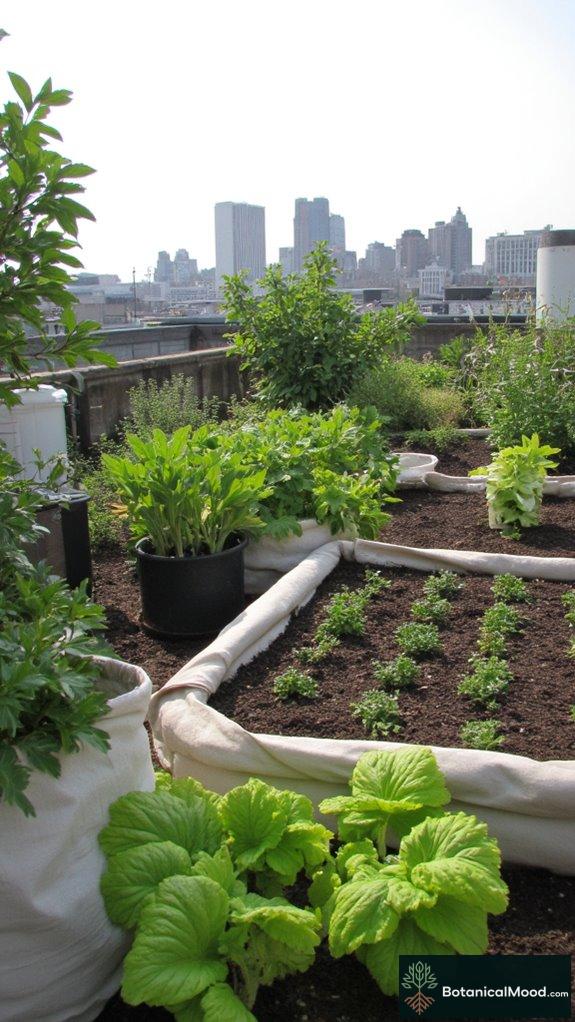
Since urban dwellers increasingly seek innovative gardening solutions, rooftop container vegetable gardens have emerged as a transformative approach to cultivating fresh produce in compact metropolitan spaces.
- Rooftop hydroponics enable year-round vegetable production with minimal water consumption.
- Lightweight containers like fabric grow bags maximize sustainable gardening potential, utilizing space-efficient designs that allow for optimal plant placement.
- Strategic plant selection includes compact varieties (Solanum lycopersicum ‘Tiny Tim’) and vertical crops.
- Modular design systems create flexible, adaptable urban agricultural environments.
- Implementing sustainable practices can enhance both crop yield and environmental benefits in urban rooftop gardens.
Balcony Railing Planter Designs
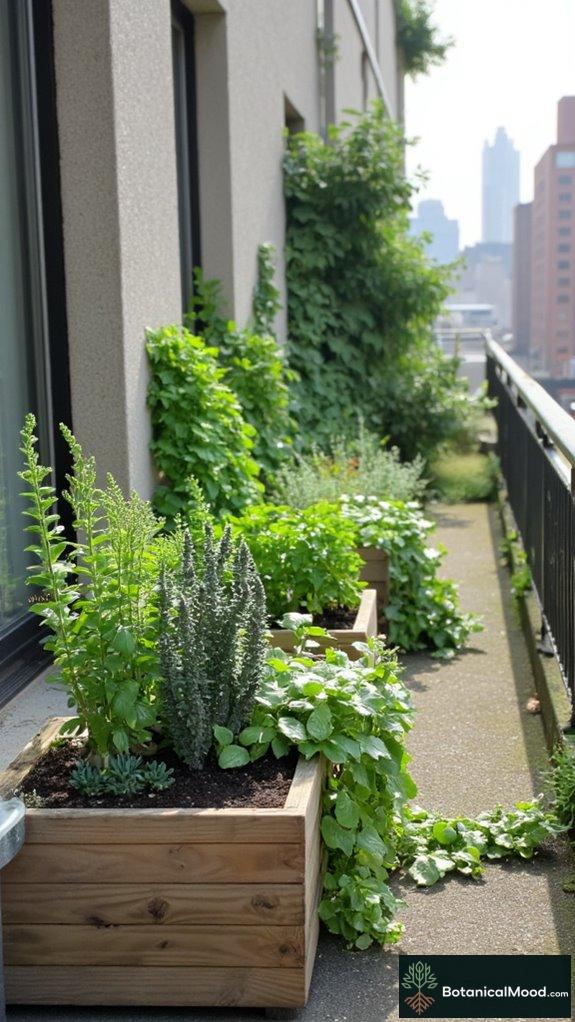
Are you searching for an ingenious way to transform your balcony’s edge into a lush, verdant canvas?
Vertical railing planters and decorative planter boxes offer urban dwellers stylish solutions for maximizing small spaces.
Wall-mounted containers enable stunning balcony flower displays, creating privacy while cultivating herbs, succulents, and vibrant ornamental greens in compact urban settings.
Window Box Micro Garden Concepts

How can tiny window ledges transform into vibrant, miniature gardens bursting with life and color?
- Select compact window box plants like thyme (Thymus vulgaris) and cascading nasturtiums for vertical garden materials.
- Use creative soil mixes optimized for small space irrigation.
- Choose decorative plant pots with sustainable gardening practices.
- Implement container gardening tips for easy care plants in urban settings.
- Vertical gardening not only maximizes space but also adds depth and interest to your designs, creating an inviting atmosphere by incorporating natural aesthetics that enhance the urban living experience.
Compact Raised Urban Garden Beds

When urban dwellers yearn for green spaces, compact raised garden beds emerge as a transformative solution for maximizing limited outdoor areas. These innovative, modular structures enable vertical gardening techniques, allowing city residents to cultivate diverse plants like herbs (Ocimum basilicum), vegetables, and compact ornamentals using strategic space-saving strategies and efficient soil management approaches. Additionally, incorporating modular vegetable garden designs can further enhance the adaptability and scalability of these garden installations. Many urban gardening enthusiasts find that creative raised bed designs can increase accessibility and provide decorative appeal to their compact gardens.
Tiered Terrace Garden Layouts

Something remarkable transforms challenging terrain topographies into stunning vertical gardens through strategic tiered terrace garden layouts.
- Sloped gardening maximizes limited urban spaces with cascading greenery.
- Multi-level landscaping creates dynamic elevation gardening experiences.
- Gradient garden styles optimize sunlight exposure for diverse plantings. Incorporating rainwater harvesting systems helps ensure these gardens remain sustainable and thrive.
- Layered floral displays (Lavandula angustifolia) enable compact, visually compelling terrace designs.
- Incorporating innovative design elements can enhance both functionality and aesthetic appeal in urban gardening spaces.
Vertical Succulent Living Walls

Because vertical succulent living walls represent an innovative approach to urban gardening, they’ve revolutionized interior and exterior design environments with their stunning, low-maintenance aesthetic. These vertical gardening installations utilize specialized mounting systems, allowing species like Sedum (stonecrop) and Echeveria to thrive in compact, architectural configurations that transform bland surfaces into living, breathing art pieces. Additionally, the use of minimalist design principles in these gardens enhances their visual appeal, creating serene spaces that promote tranquility in urban settings. These living walls not only provide functional green spaces but also contribute to improved air quality and biodiversity in urban areas.
Micro Hydroponic Urban Systems
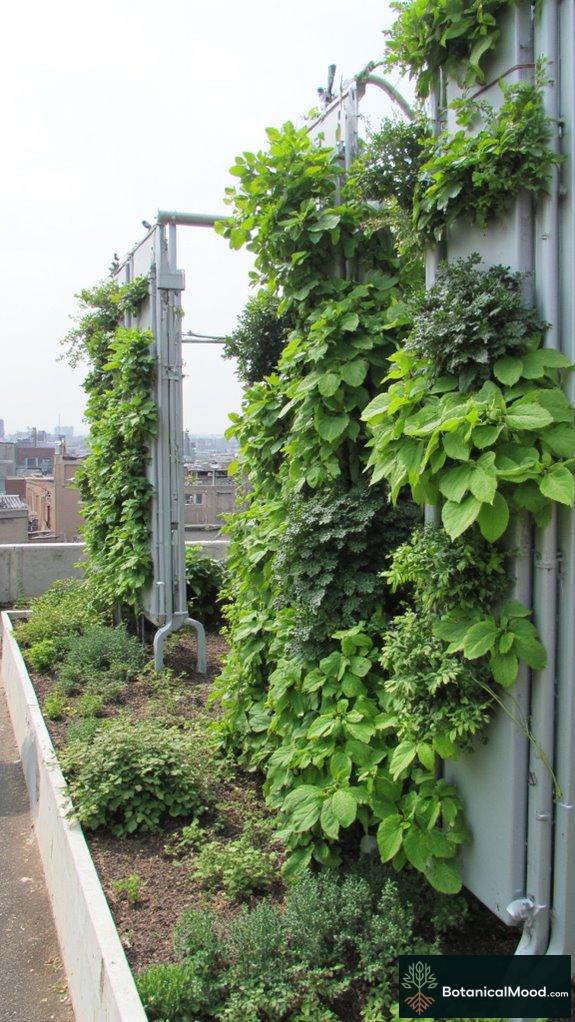
As urban environments continue to evolve, micro hydroponic urban systems have emerged as a groundbreaking solution for sustainable, space-efficient food production in metropolitan areas.
- Micro reservoir technology enables compact nutrient solution management
- Vertical growing panels maximize limited urban spatial configurations
- Automated climate control optimizes plant growth parameters
- Modular design allows scalable, adaptable urban agricultural systems
Compact Aquaponic Garden Designs
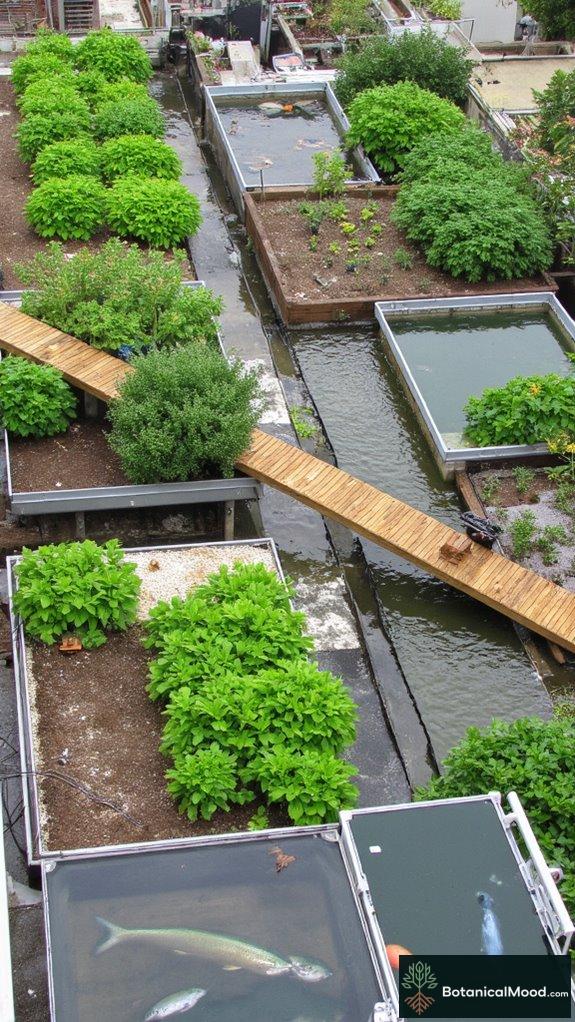
Building upon the innovative urban agricultural techniques explored in micro hydroponic systems, compact aquaponic garden designs represent a symbiotic evolution of sustainable food production that harmonizes fish cultivation with plant growth.
These integrated systems utilize aquaponic fish tanks to create self-sustaining ecosystems where nutrient-rich water from fish waste nourishes thriving vegetable and herb gardens.
Small Space Vertical Herb Gardens
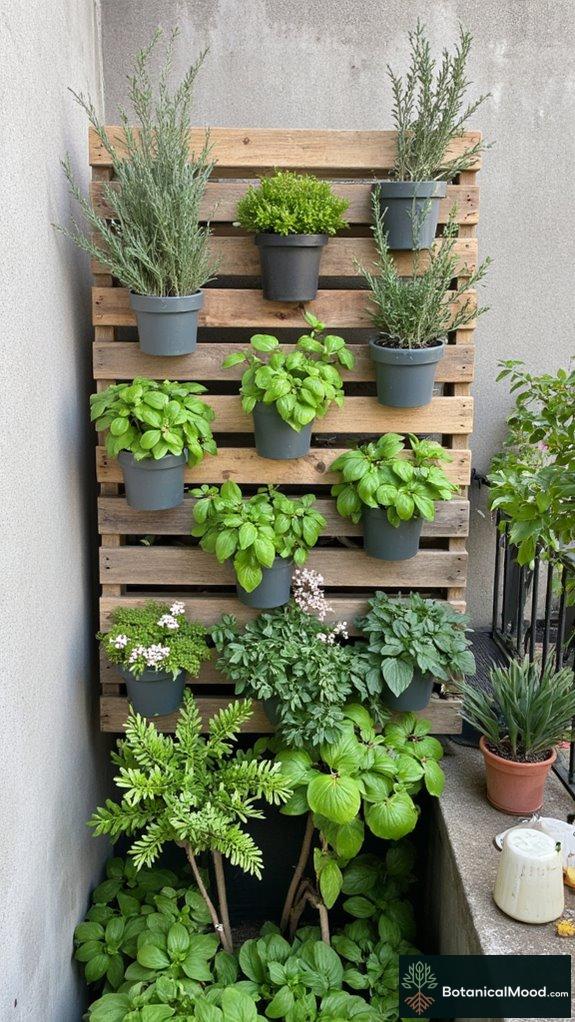
Vertical herb gardens revolutionize small-space gardening, transforming compact urban environments into lush, green sanctuaries of culinary potential.
- Innovative herb garden kits maximize vertical surfaces with modular indoor herb pots, creating stunning organic herb gardening displays.
- Hydroponic herb systems integrate seamlessly into kitchen herb supplies, offering portable herb gardens with minimal maintenance. These systems utilize soilless growth methods, allowing herbs to thrive in limited spaces.
- Balcony herb planters featuring medicinal herb cultivation enable urban dwellers to grow diverse herbal collections.
- Herb drying racks complement vertical growing strategies, ensuring fresh culinary and tea garden resources.
Additionally, incorporating DIY vertical herb garden techniques can enhance the aesthetic and functional aspects of your urban garden setup.
Modular Stackable Planter Solutions

While maximizing garden potential requires innovative design strategies, modular stackable planter solutions represent a revolutionary approach to contemporary small-space gardening. These versatile systems enable vertical space optimization, allowing gardeners to transform limited urban areas into lush, productive green spaces through intelligent, aesthetically pleasing modular planting configurations that maximize both functionality and visual appeal. Additionally, incorporating modular expansion planning allows for future growth and adaptability as gardening needs evolve. By utilizing modular raised garden beds, gardeners can create unique layouts that not only enhance plant accessibility but also facilitate a higher yield in confined areas.
Tiny Courtyard Garden Transformations

How can you transform a diminutive courtyard into a verdant sanctuary of beauty and tranquility?
- Leverage vertical gardening techniques with modular wall-mounted planters (Hedera helix) to maximize urban space utilization.
- Implement multi-functional furniture with integrated botanical elements.
- Use reflective surfaces to create optical expansion of tiny garden aesthetics, enhancing the sense of spatial brightness within the garden.
- Select compact, architectural plants that provide dramatic visual impact without overwhelming limited square footage.
- Consider incorporating minimalist landscape planning principles to enhance the harmony and simplicity of your garden design.
Urban Micro Greenhouse Setups

Because urban dwellers increasingly seek sustainable food production solutions, micro greenhouse setups have emerged as ingenious responses to limited spatial constraints. My compact greenhouse design integrates vertical hydroponic systems, modular shelving, and energy-efficient LED grow lights, maximizing urban greenhouse benefits through creative installation techniques that transform small balconies and windowsills into productive miniature cultivation zones. Additionally, incorporating native plants for pollinators can further enhance the ecological value of these urban gardens by supporting local ecosystems. Creating these spaces can also promote pollinator-friendly plants that provide essential resources for urban wildlife.
Minimalist Zen Balcony Gardens

As urban micro greenhouses transform compact spaces into productive zones, minimalist Zen balcony gardens represent another innovative approach to creating serene outdoor retreats within metropolitan environments.
- Incorporate zen garden accessories like smooth river stones (Lithobates catesbeianus).
- Create tranquil seating areas with low-profile minimalist furniture.
- Use monochromatic color palettes of gray, white, and sage green.
- Install compact water features with subtle bamboo elements (Phyllostachys aurea), which can enhance the overall atmosphere of tranquility characteristic of modern zen gardens.
Additionally, incorporating smooth river stones can enhance the calming effect of these gardens, reflective of traditional Japanese Zen garden design principles.
Hanging Macramé Plant Displays
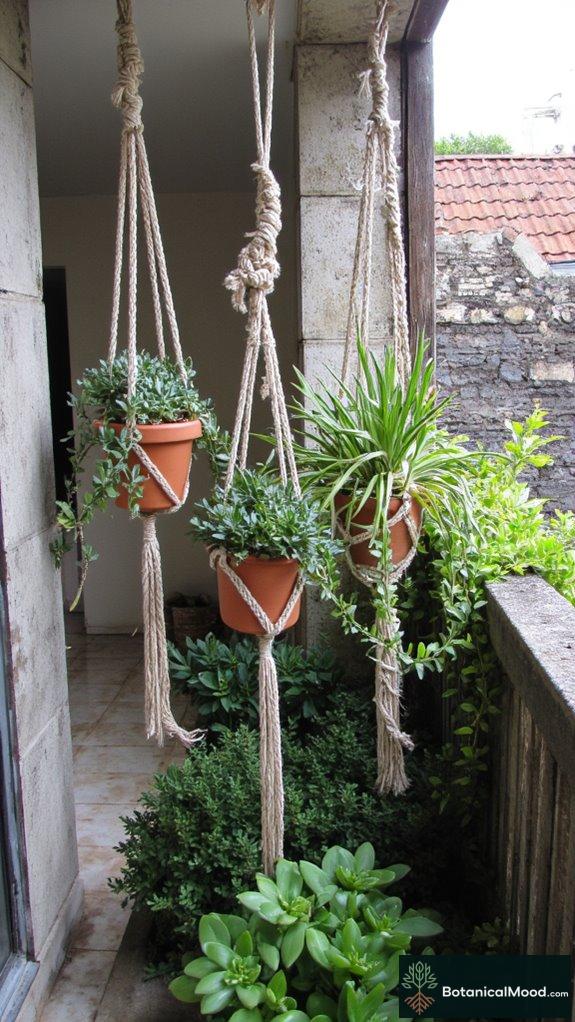
Macramé plant displays have emerged as a contemporary design trend that transforms vertical spaces into living art installations, blending bohemian textile craftsmanship with botanical elegance.
I’ve discovered these stylish plant hangers can elevate indoor and outdoor spaces, utilizing creative knotting techniques with sustainable materials like organic cotton and hemp, creating dynamic botanical compositions that reflect personal aesthetic sensibilities.
Repurposed Container Garden Ideas

Upcycling breathes new life into forgotten household items, transforming them into stunning garden containers that reflect creativity and sustainability.
- Old wooden crates become charming planters for herbs (Ocimum basilicum) and succulents.
- Recycled plastic pots add vibrant color to urban balconies, enhancing the overall appeal of container gardening in limited spaces.
- Industrial metal buckets host drought-resistant Mediterranean plants.
- Vintage ceramic teapots create whimsical vertical garden displays.
Additionally, decorative wooden garden planters can enhance the overall aesthetics of your space while providing functionality.
Narrow Side Yard Garden Layouts

Narrow side yards often represent overlooked gardening opportunities, transforming these slim spaces into verdant, purposeful settings that maximize limited square footage.
Compact Vertical Strawberry Gardens

While maximizing vertical gardening potential in compact urban spaces, strawberry gardens offer an ingenious solution for home gardeners seeking delicious, space-efficient fruit production.
- Design a stunning strawberry tower using modular vertical hydroponics systems.
- Integrate lightweight, stackable planters with drainage for Fragaria × ananassa varieties.
- Optimize sunlight exposure with strategic wall-mounted growing configurations. Sustainable DIY interlocking planters can create modular gardens that easily fit into various urban layouts, enhancing your gardening design.
- Implement water-efficient irrigation techniques for consistent fruit development. Additionally, these systems can significantly enhance sustainable water management practices in urban gardening spaces.
Windowsill Microgreen Growing Systems

Every gardening enthusiast can transform a sunny windowsill into a productive microgreen growing system, creating a vibrant indoor ecosystem that delivers fresh, nutrient-dense greens throughout the year.
Compact trays with specialized windowsill lighting enable cultivation of diverse microgreen varieties like amaranth (Amaranthus), radish (Raphanus sativus), and kale (Brassica oleracea), providing continuous harvests of nutritional microgreens in minimal urban spaces.
Urban Bamboo Screening Gardens

Modern urban environments increasingly demand creative privacy solutions, and bamboo screening gardens represent an elegant, sustainable approach to transforming exterior spaces.
- Bamboo (Phyllostachys aurea) creates stunning green shadows that enhance garden aesthetics.
- Sustainable materials provide sound insulation and support local wildlife habitats.
- Strategic placement generates urban microhabitats with decorative ecological balance.
- Innovative screening techniques offer dynamic privacy solutions for compact urban settings.
Movable Garden Trolley Designs
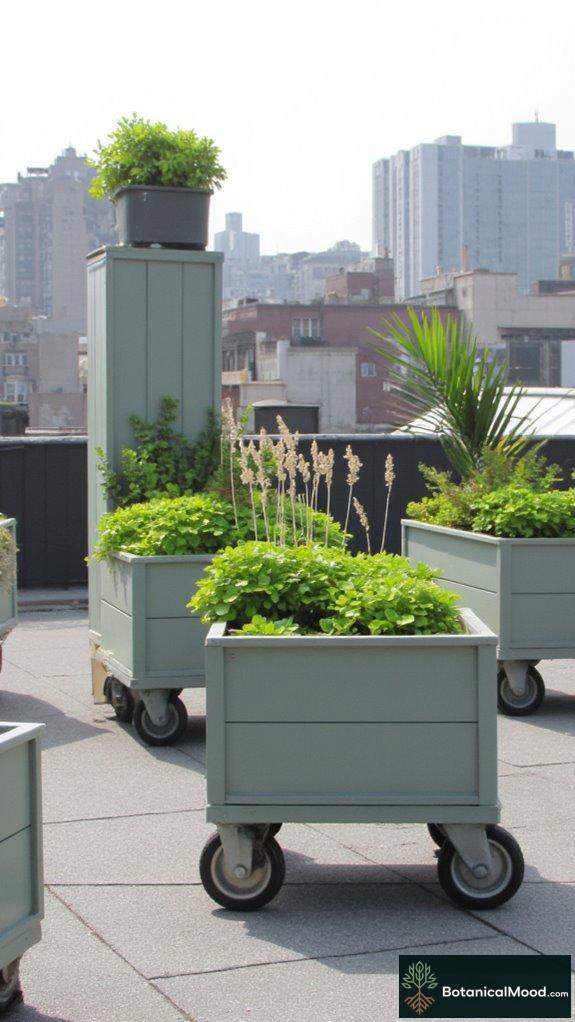
Gardens evolve dynamically, and movable garden trolleys offer innovative solutions for flexibility in landscaping design.
Multi-tiered, collapsible garden trolleys with adjustable heights transform urban gardening, providing portable plant stands that maximize small spaces efficiently.
Ergonomic, stylish planter trolleys enable gardeners to create movable green environments with ease and adaptability.
Floating Shelf Plant Installations
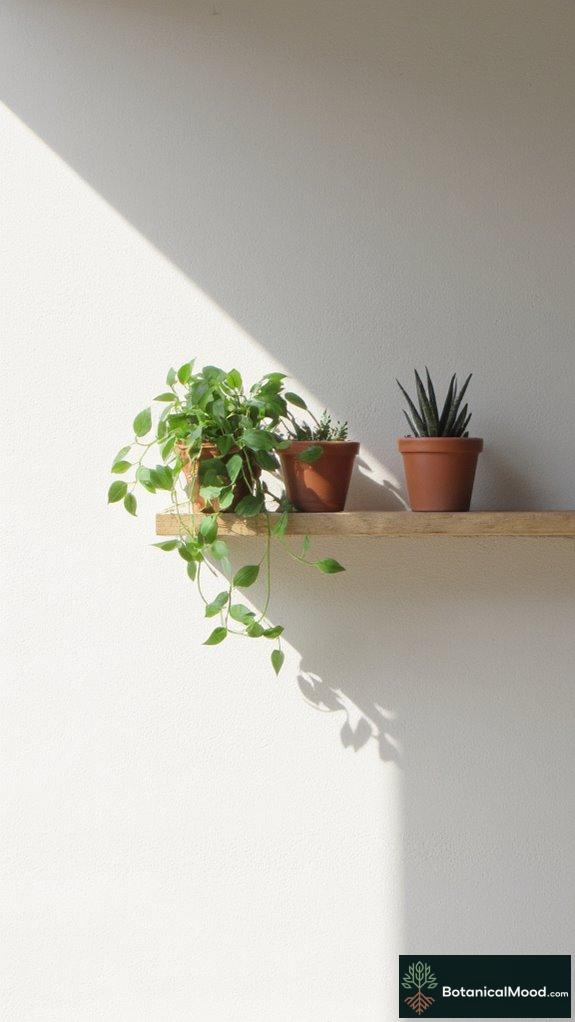
When considering vertical gardening solutions, floating shelf plant installations emerge as an ingenious method for transforming interior and exterior spaces with botanical elegance.
- Maximize shelf plant placement through strategic mounting techniques.
- Create dynamic visual compositions with multi-level arrangements.
- Incorporate lightweight containers (terracotta, ceramic, metallic).
- Select plants with cascading growth habits like trailing pothos (Epipremnum aureum).
Additionally, exploring creative garden layouts can enhance your garden’s overall aesthetic and functionality.
Compact Pollinator Garden Concepts
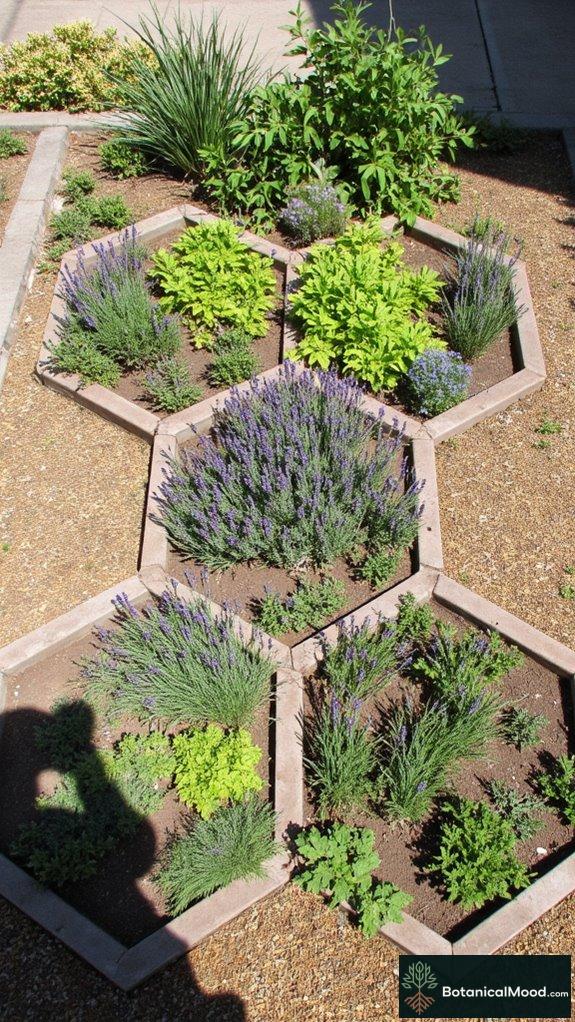
Because pollinators play an essential role in ecosystem health and garden vibrancy, designing compact pollinator gardens represents an innovative approach to supporting biodiversity in limited spaces. Native flower selection like Echinacea (Echinacea purpurea) and strategic plant companion pairings create sustainable wildlife habitat zones that attract beneficial insects while enhancing urban biodiversity through intelligent environment layering techniques. Implementing native flower selection ensures that the garden thrives while providing essential resources for both pollinators and other wildlife. Additionally, incorporating nectar-rich plants can further increase the attractiveness of your garden for various pollinator species.
Vertical Vegetable Trellis Systems

Maximizing garden productivity through vertical vegetable trellis systems transforms compact spaces into lush, efficient growing environments.
Here’s how to elevate your urban gardening strategy:
- Explore innovative trellis material options like reclaimed wood, metal wire, and bamboo frames.
- Select compatible vegetable climbing varieties such as pole beans (Phaseolus vulgaris) and climbing cucumbers.
- Design sustainable, space-saving trellis systems with modular, adaptable configurations.
- Implement DIY vertical gardening techniques to maximize limited urban garden spaces. Incorporating sustainable aesthetics into your garden design can enhance both its function and visual appeal.
Adding a vertical garden can also enhance aesthetic appeal, creating a visually stunning environment that combines beauty and functionality.
Tiny Meditation Garden Spaces

Although urban living often constrains personal sanctuary spaces, tiny meditation gardens can transform even the most compact environments into serene retreats.
By integrating mindfulness features like zen motifs, reflective surfaces, and fragrant plants (Lavandula angustifolia), I’ve discovered how sensory textures and nature sounds can create tranquility elements in peace corners.
This enables urban dwellers to cultivate meditative spaces within limited square footage.
Portable Urban Garden Modules

When urban environments constrict gardening possibilities, portable garden modules emerge as innovative solutions for city dwellers seeking green sanctuaries.
These versatile designs offer urban gardeners transformative opportunities:
- Lightweight, modular planting systems that maximize limited spaces
- Customizable garden modules with integrated mobile gardening options
- Space-saving installations featuring portable garden technology
- Adaptable urban garden configurations enabling green living anywhere
Additionally, these modules can help create a lush urban oasis by allowing residents to cultivate plants creatively in their limited outdoor spaces. Many urban gardeners are turning to container gardening as an effective means to utilize vertical space and grow a variety of lush plants.
Compact Rain Garden Designs
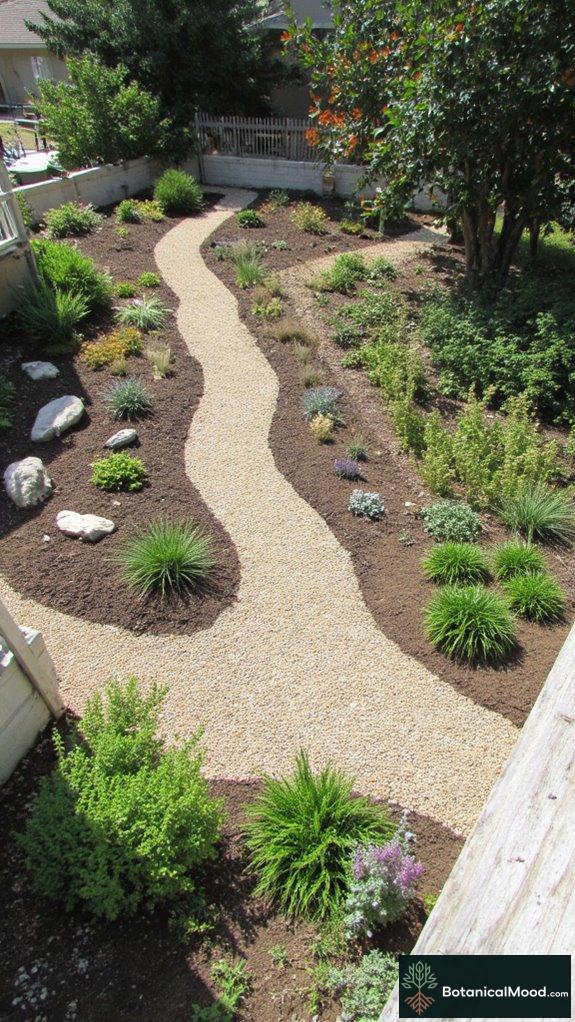
Rain gardens represent a sustainable solution for managing stormwater runoff while creating beautiful, ecologically responsible terrain features that seamlessly adapt from portable urban garden modules. I’ll design compact rain gardens using native plantings like Echinacea (Echinacea purpurea) and integrating permeable paving solutions to enhance urban wildlife habitats and improve soil quality through strategic rainwater harvesting techniques. Incorporating xeriscaping garden planning will further optimize water efficiency and promote drought-resistant plant choices. Native plants not only thrive in local climates but also support local ecosystems, making them an excellent choice for urban gardening.
Indoor Vertical Garden Walls

Since urban dwellers increasingly seek innovative ways to incorporate greenery into limited living spaces, indoor vertical garden walls have emerged as a transformative design solution that maximizes spatial efficiency while introducing vibrant botanical elements to interior environments.
- Select modular wall systems with integrated indoor garden lighting for peak plant health.
- Choose air-purifying species like spider plants (Chlorophytum comosum) and snake plants (Sansevieria trifasciata).
- Implement humidity control methods to support vertical garden ecosystem.
- Utilize eco-friendly materials for sustainable, aesthetically pleasing indoor garden installations.
Minimalist Concrete Planter Concepts

After exploring vertical garden solutions that transform interior spaces, minimalist concrete planters offer an elegant counterpoint—a sculptural approach to garden design that emphasizes clean lines, geometric forms, and understated sophistication. These innovative designs leverage raw concrete textures, creating architectural statements that blend functionality with pure aesthetic minimalism in contemporary urban environments. Their durability and modern appeal make them a popular choice for urban gardens that require low maintenance and innovative aesthetics. Additionally, incorporating elements of sustainable garden design can enhance the effectiveness of these planters by supporting local biodiversity and reducing environmental impact.
Urban Edible Landscape Designs
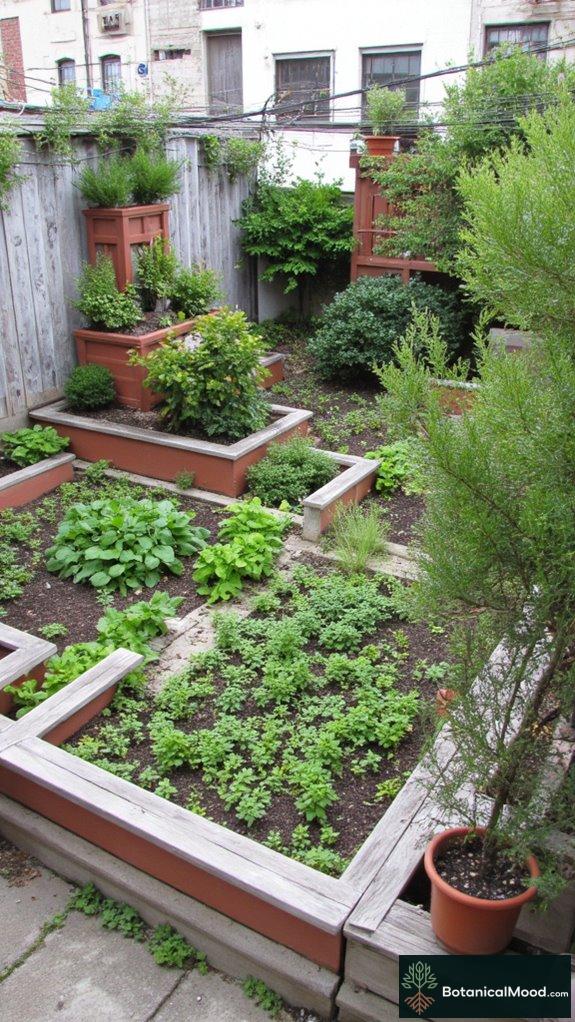
How can urban dwellers transform limited spaces into productive, beautiful edible terrains?
Here’s my innovative approach to urban agriculture:
- Vertical farms maximize compact city spaces, integrating edible plants (Solanum lycopersicum) into architectural designs. Incorporating fruit trees can provide both shade and food.
- Rooftop foraging creates community-driven urban forest ecosystems.
- Neighborhood gardens transform concrete environments into local food production zones.
- Strategic edible landscaping merges aesthetic beauty with sustainable agriculture principles.
To further enhance these urban environments, incorporating modern permaculture strategies can optimize land use and create more resilient ecosystems.
Small Space Japanese Garden Ideas

Whether nestled on a compact urban balcony or tucked into a diminutive backyard, Japanese gardens represent an exquisite art form of miniaturization and contemplative design, transforming even the smallest spaces into profound meditative settings. Zen garden aesthetics, with minimalist water features like small stone basins (tsukubai) and carefully placed rocks, create serene, transformative scenery that invites introspection and tranquility. Incorporating asymmetrical layouts is essential, as this creates a natural flow that enhances the tranquil atmosphere. To deepen the sense of peace, consider adding natural elements such as moss or bamboo that harmonize with the garden’s overall design.
Compact Butterfly Garden Layouts

Since pollinators play an essential role in ecosystem health, designing a compact butterfly garden requires strategic plant selection and thoughtful spatial arrangement to maximize attractiveness and ecological benefit.
- Select diverse nectar sources like Echinacea (Echinacea purpurea) and Lantana to attract multiple butterfly species.
- Create layered garden placement with varying plant heights for visual interest.
- Incorporate butterfly host plants such as milkweed to support complete lifecycle, as these plants are crucial for the survival of caterpillars.
- Design with seasonal blooms and color combinations to maintain year-round pollinator engagement.
Additionally, incorporating native plants will enhance the garden’s ability to support local native bee populations and promote biodiversity.
Vertical Citrus Tree Growing Methods

Growing citrus trees vertically offers urban gardeners and space-constrained enthusiasts an innovative solution for producing fresh, homegrown fruit in compact environments.
Strategic trellising techniques like espalier and wall-mounted containers maximize vertical space while ensuring ideal sunlight exposure for Citrus sinensis (orange) and Citrus limon (lemon) varieties.
This enables efficient nutrient delivery and streamlined pest management through targeted organic interventions.
Urban Permaculture Garden Systems

Because urban environments increasingly demand innovative agricultural solutions, permaculture garden systems represent a holistic approach to transforming limited city spaces into productive, self-sustaining ecosystems.
- Urban soil health becomes critical through strategic composting practices and regenerative agriculture techniques.
- Sustainable water management integrates ecological pest control with native plant (Echinacea purpurea) strategies.
- Biodiversity enhancement promotes urban wildlife habitats and edible landscaping designs.
- Community garden initiatives leverage agroecological practices for climate resilience gardening.
- Incorporating permaculture design principles allows for optimal resource use and sustainability in dense urban settings.
Compact Sensory Garden Designs

When urban dwellers desire immersive garden experiences within limited spaces, compact sensory garden designs emerge as transformative solutions for engaging multiple human perceptions through strategic botanical arrangements. These innovative spaces integrate fragrant plants (Lavandula angustifolia), tactile elements, and sound gardens to create immersive experiences that stimulate sensory pathways, delivering calming ambiance through carefully curated nature scents and interactive installations. Additionally, the incorporation of therapeutic landscape elements can enhance mental wellness, fostering a deeper connection between the environment and individuals. By incorporating natural elements such as flowing water or rustling branches, these gardens can further enhance the sensory experience, promoting relaxation and mindfulness.
Modular Green Roof Gardens

Since metropolitan environments increasingly demand innovative urban greening strategies, modular green roof gardens represent a sophisticated architectural solution for transforming previously unused vertical spaces into vibrant, ecological environments. To enhance biodiversity, draw inspiration from native wisdom by incorporating local plant species that support the surrounding ecosystem. Implementing effective drought resistance practices can further improve the resilience of these gardens.
- Utilize modular plant structures (Sedum spp.) for lightweight, adaptable rooftop ecosystems.
- Implement innovative irrigation systems supporting sustainable urban wildlife habitats.
- Integrate solar panel compatibility with green roof sustainability designs.
- Leverage eco-friendly materials for stormwater management solutions.
Small Space Water Feature Gardens
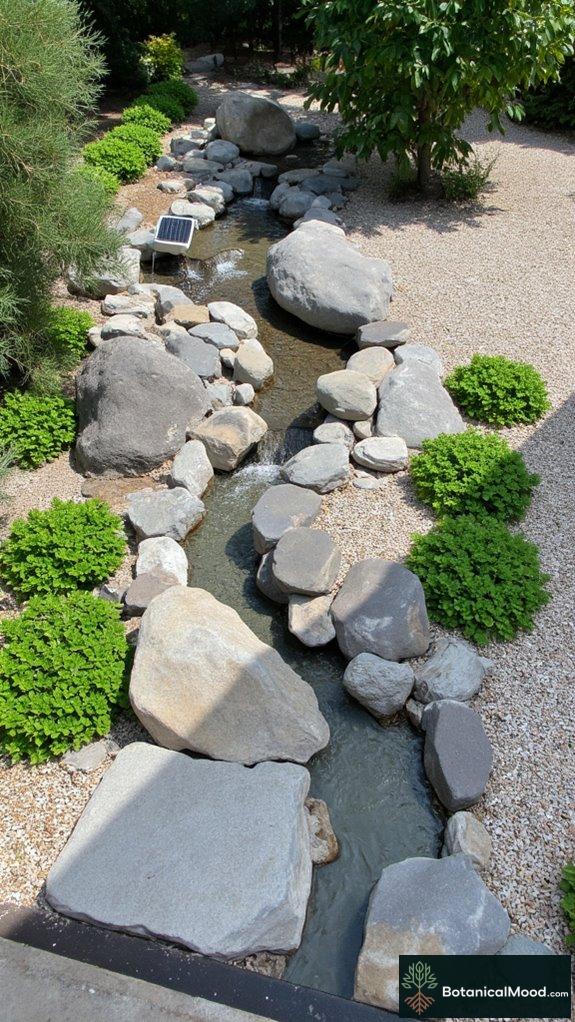
Every urban dweller yearns for a tranquil aquatic retreat, and small space water feature gardens offer an ingenious solution for transforming compact outdoor areas into serene, meditative environments.
I’ve discovered innovative designs like miniature creek layouts, solar-powered fountains, and reflective pool concepts that maximize limited urban spaces while creating stunning aquatic scenes with minimal environmental impact.
Vertical Composting Garden Solutions
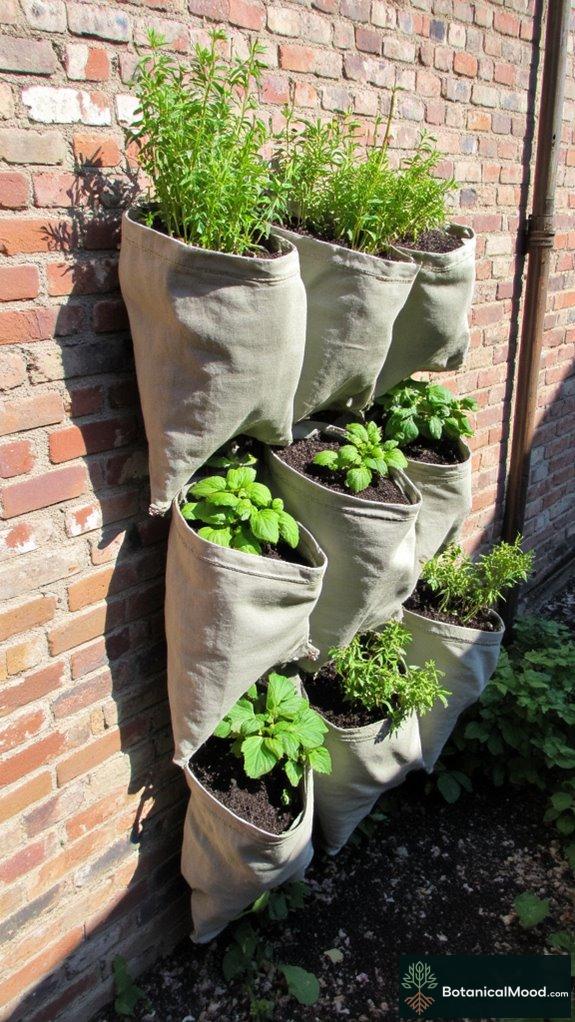
From the soothing sounds of miniature water features, urban gardeners can now explore vertical composting solutions that transform small spaces into productive green havens.
- Install a modular worm bin (Eisenia fetida) against a sunny wall.
- Create multi-tiered vertical composting systems with breathable fabric pockets.
- Harvest nutrient-rich compost tea for container garden fertilization.
- Maximize limited urban space with compact, stackable composting designs.
Urban Medicinal Herb Gardens

Crafting an urban medicinal herb garden transforms any compact city space into a vibrant sanctuary of healing potential and botanical diversity.
Compact Rock Garden Designs

Some rock gardens emerge as miniature vistas that capture the rugged beauty of alpine and desert terrains within surprisingly compact urban spaces.
My design approach focuses on:
- Strategic boulder placements creating zen-like tranquility
- Drought-resistant succulent arrangements (Sedum spathulifolium)
- Native rock varieties with efficient drainage solutions
- Pebble pathway designs featuring subtle color combinations
Hanging Pocket Garden Systems
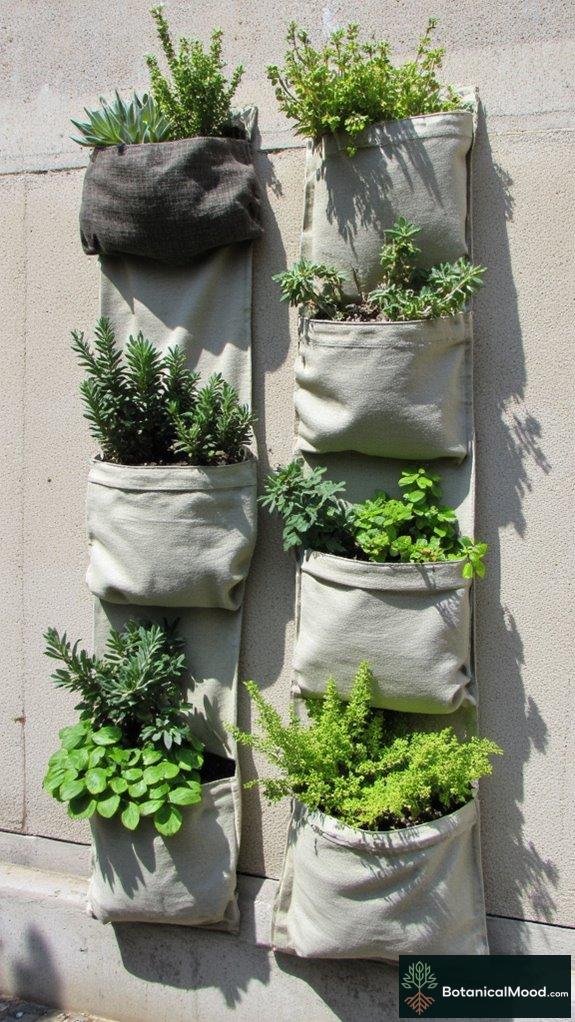
Whether you’re working with a balcony, small patio, or urban courtyard, hanging pocket garden systems offer an innovative solution for cultivating lush greenery in limited spaces.
These modular designs maximize vertical settings, utilizing lightweight fabric pockets that enable strategic plant selection, water-efficient irrigation, and seamless space optimization for urban gardening enthusiasts seeking creative, adaptable green solutions.
Urban Microclimate Garden Concepts
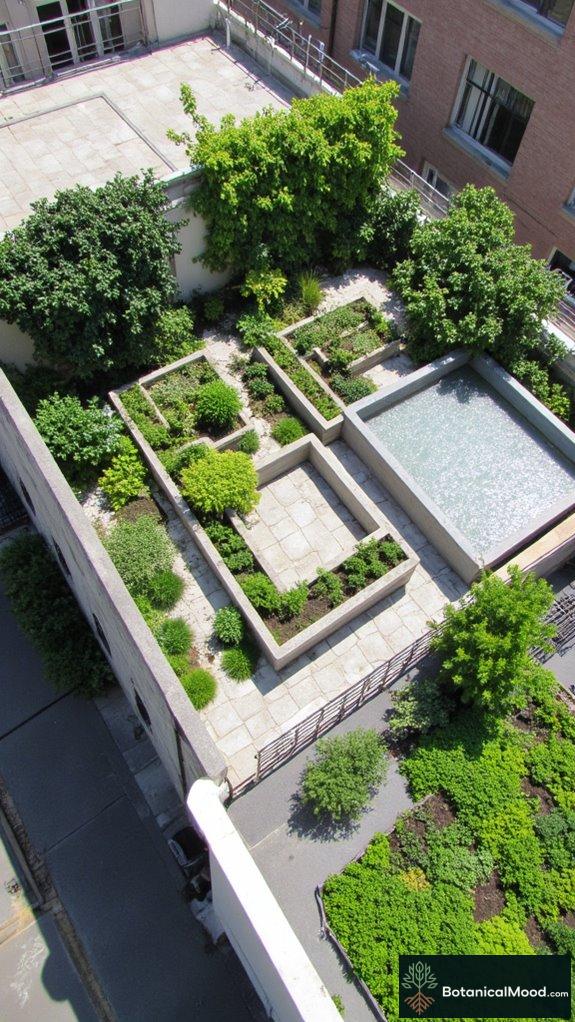
Urban vistas present unique challenges and opportunities for gardeners seeking to transform restricted environments into vibrant green sanctuaries.
- Microclimates optimize plant growth by leveraging localized temperature, humidity, and wind protection strategies.
- Strategic positioning enhances urban biodiversity through intelligent terrain design.
- Vertical gardening techniques maximize limited spatial configurations.
- Innovative materials like recycled containers create dynamic ecosystem interfaces.
My Botanical Mood approach champions transformative urban garden experiences.
Tiny Shade Garden Layouts
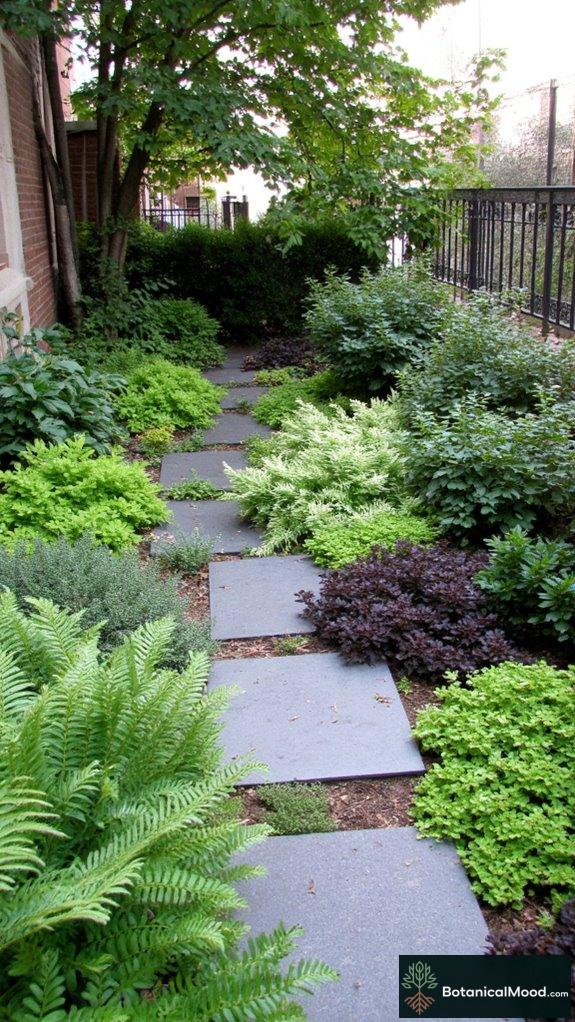
Shadows dance across compact terrains, transforming diminutive shade garden spaces into intimate botanical sanctuaries where low-light tolerant plants thrive.
Strategic shade plant selection, like Hosta (Hosta spp.) and Heuchera (Heuchera spp.), enables vibrant design within challenging urban microclimates, incorporating moisture retention techniques and creative lighting solutions to cultivate dynamic, wildlife-friendly miniature ecosystems.
Vertical Edible Wall Designs
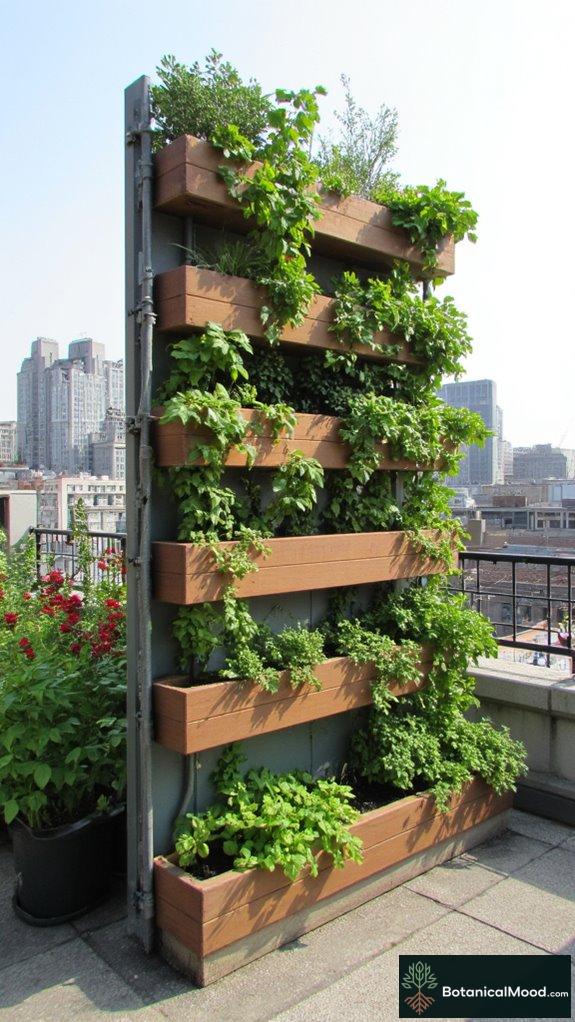
How can you transform blank walls into lush, productive vistas?
- Install modular vertical garden systems with integrated vertical garden irrigation for herbs like basil (Ocimum basilicum) and compact vegetables.
- Design stackable planter configurations maximizing edible wall maintenance efficiency.
- Select lightweight, water-resistant materials ensuring structural integrity and plant health.
- Incorporate drip irrigation mechanisms for consistent moisture distribution.
Compact Native Plant Gardens

After transforming vertical walls into edible terrains, garden enthusiasts can shrink their ecological footprint by designing compact native plant gardens that celebrate local biodiversity and minimize environmental impact.
These microgardens integrate native flora (Echinacea purpurea, Solidago speciosa) to support pollinators, enhance soil health, and create vibrant seasonal vistas with minimal water requirements.
Urban Container Orchard Designs

Urban Container Orchard Designs transform small city spaces into productive, miniature ecosystems that yield fresh fruit without requiring expansive land.
These innovative designs maximize urban gardening potential through:
- Vertical gardening techniques with dwarf fruit trees (Malus domestica)
- Sustainable irrigation systems
- Pollinator habitat integration
- Multi-crop space optimization strategies
Transforming limited urban environments into edible, aesthetic settings.
Small Space Pollinator Corridors
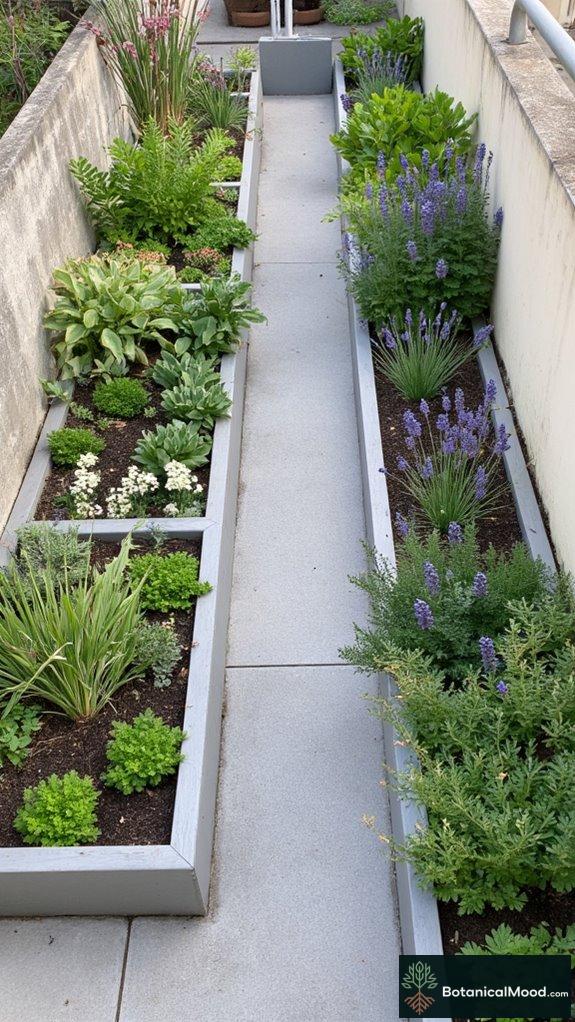
Because pollinators are the unsung heroes of ecosystem health, small space pollinator corridors represent critical micro-habitats that can transform even the most compact urban environments into vibrant ecological networks.
Strategically designing narrow garden spaces with native nectar-rich plants like Echinacea (Echinacea purpurea) and Lavandula angustifolia creates sustainable urban bee habitats that support butterfly attracting flowers and insect biodiversity.
Vertical Kitchen Garden Systems
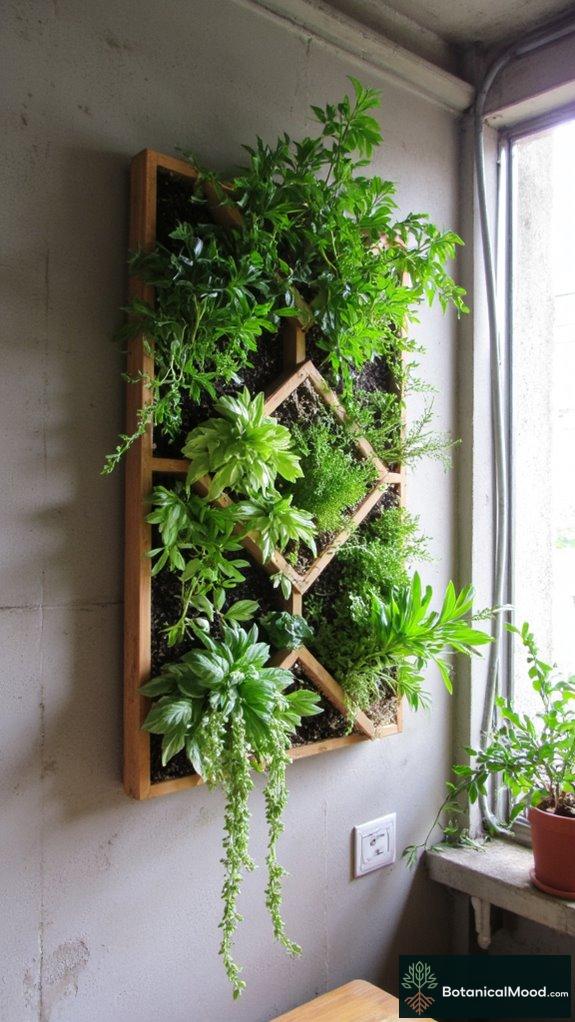
Five innovative vertical kitchen garden systems can revolutionize how home gardeners maximize limited space while cultivating fresh, organic produce directly adjacent to culinary preparation areas.
- Hydroponic wall panels offer energy-efficient food production with sleek design aesthetics.
- Modular hanging herb planters maximize urban efficiency.
- Stackable vertical hydroponics enable sustainable agriculture indoors.
- Magnetic kitchen-integrated growing systems transform culinary spaces (Solanum lycopersicum cultivation).
Minimalist Urban Garden Aesthetics
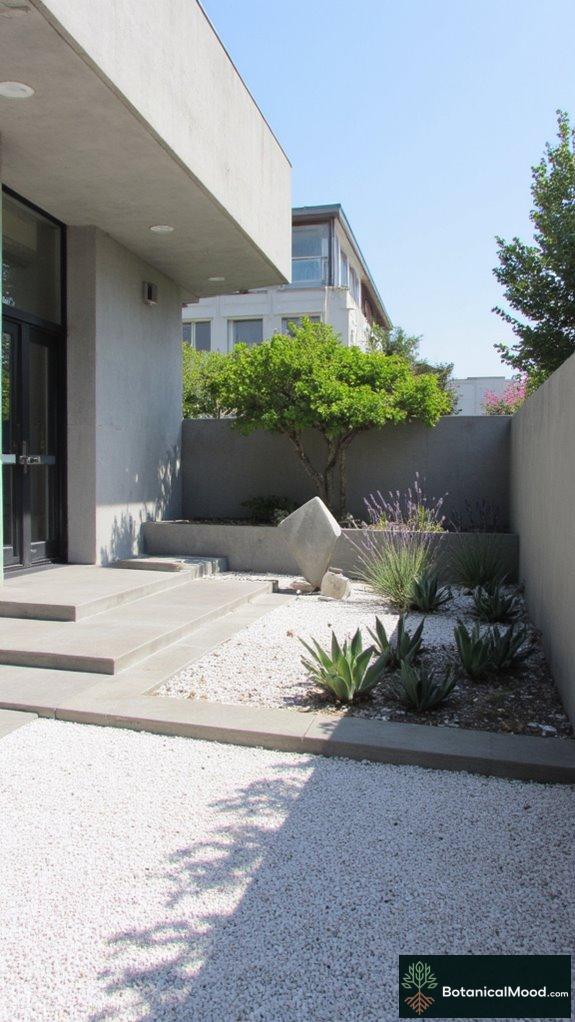
When designing minimalist urban gardens, architects and environmental designers increasingly prioritize clean lines, functional spatial arrangements, and strategic plant selection to transform compact environments into serene, sophisticated green spaces.
I curate sustainable design materials and minimalist garden furniture that emphasize simplicity, using monochromatic palettes, geometric planters, and carefully selected specimens like Lavandula angustifolia (lavender) to create visually harmonious, low-maintenance urban retreats that maximize limited spatial potential.

Leave a Reply